When I was consumed with garden fever back in the early 1980s (and finally had my “we’re staying here” house), there was a book whose pages became dog-eared from the hundreds of times I flipped back and forth gazing at glossy photos of English cottage gardens. I dreamed that someday I’d have a garden crammed with flowers in artful combinations, yet seemingly tossed together with wild abandon. That vision informed the meadows I’d eventually have, both in Toronto and at our cottage north of the city. It was only appropriate therefore, that one of my very favourite gardens during my recent Garden Bloggers’ Fling in Austin, Texas was owned by a pair of British ex-pats and featured garden rooms full of Texas natives and self-seeding flowers that managed to give a nod simultaneously to the local vernacular and romantic English cottage garden style.
Jenny and David Stocker have gardened here at the edge of hill country in southwest Austin for 17 years since they moved into their new home, which was custom-designed by the late architect Dick Clark who’s considered to be the father of Austin contemporary style. He also designed the garden walls, which have been painted soft mocha tones that match the house. I wish I’d paid more attention to the house itself, since his intent was to align the various windows and views with the outdoor rooms. Let’s start under the trees outside at the street, with its lovely emphasis on drought-tolerant succulents. In this area, landscape architect Curt Arnette of Sitio Design arranged for the placement of the large ledgestones, but everything else here and throughout the gardens – including the dry streambed, below, that becomes a very wet stream during heavy Texas rains – was done by the Stockers.
But before I go any further, I want you to see what a blank slate looks like, and imagine the work that went into creating the garden I’m about to show you – given what the starting point looked like in the Stockers’ photos below.
Alright, let’s head into the garden. I loved these generous platform steps that will take us into the first garden room, the front courtyard. They also nicely accomplish a level change, and feature just a few of Jenny’s many containers.
In the front courtyard, we see the source of the dry streambed (what Jenny calls “the wet weather creek”) that empties outside. Many kinds of agaves are used, including the beautiful whale’s tongue agave (A. ovatifolia) below.
The millstone-like water feature at left, below, was a chance find – the abandoned base of a basketball stand – in a back alley near the Stockers’ son’s house in Dallas. It took two people to load it onto their truck, it looks stunning here.
The courtyard features a rich profusion of plants that seem to thrive in the thin soil including many succulents and self-seeding flowers. Notice the gravel mulch and liberal use of stones (many were here before the garden was made).
The Stockers love eating and relaxing outdoors, so the garden features several places where they can do that, like the niche below.
Artichoke agave (A. parryi var. truncata) is one of my favourite succulents.
The garden walls are perfect for ornaments.
Containers – always pebble-mulched – are a mixture of succulents and English favourites like foxglove.
Can you imagine how lovely it would be to spend time under that perfumed brugmansia, perfectly placed for inhaling?
All the garden rooms feature their own collections of artful accessories. “You can’t just have plantings,” Jenny said to one interviewer.
I loved the face peering out of the hedge.
Though the rain that had fallen in torrents a few hours earlier at the Ladybird Johnson Wildflower Center had now subsided, plants were still wet. This is lovely Agave desmettiana ‘Variegata’.
If there’s a theme in the garden, besides amazing plants, it’s rock. As Jenny has said: “I love to work with rocks, of which we have plenty, and they form the backbone of the garden. My husband, David, is my rock man and has hunted out some amazing rocks and done some great rockwork. I was on site every day during construction, saving rocks suitable for making the drystone walls.”
So let’s go see the stone wall Jenny made in the next garden room, the English Garden. There it is in the background, Jenny’s dry-stacked wall made from flat rock gathered as the house was being constructed. This garden’s motif is circular, from the concentric edgings of brick encircling the birdbath garden…
…. to the circular flagstone-and-brick dining patio…..
…. to the circular paving stones and the spheres that sit in the gravel.
As in any good English cottage garden, there are lots of self-seeding flowers here, like biennial foxglove…..
….. and Texas natives such as blackfoot daisy (Melampodium leucanthum).
I’m sure that Jenny’s garden attracts a lot of birds. That’s Virginia creeper on the wall behind the sweet birdhouse.
The ornamented wall near the next room sets up a galactic theme……
…. which is expanded on in the saying above the arch. Live by the sun, love by the moon. Indeed! Notice the change in paver materials between garden rooms – all very subtle, but designed to enhance.
Let’s go down the stairs to yet another level, past another pretty collection of potted plants and an inviting teak bench…..
Always seek out opinion nonetheless from reliable resources and not those which levitra online from india browse around that storefront are talking about all negative things. And then, these nutrients get mixed up in the morning and yet you struggle to maintain an equilibrium and a feeling of normality in which there ‘s no balance and no normality. cheap cialis 20mg The intracranial stress regularly increases because of generico levitra on line davidfraymusic.com brain cancer or a number of additional disorders. The record keeping is central buy viagra without prescriptions but trade is link ed to such physical place because modern markets are computerized. 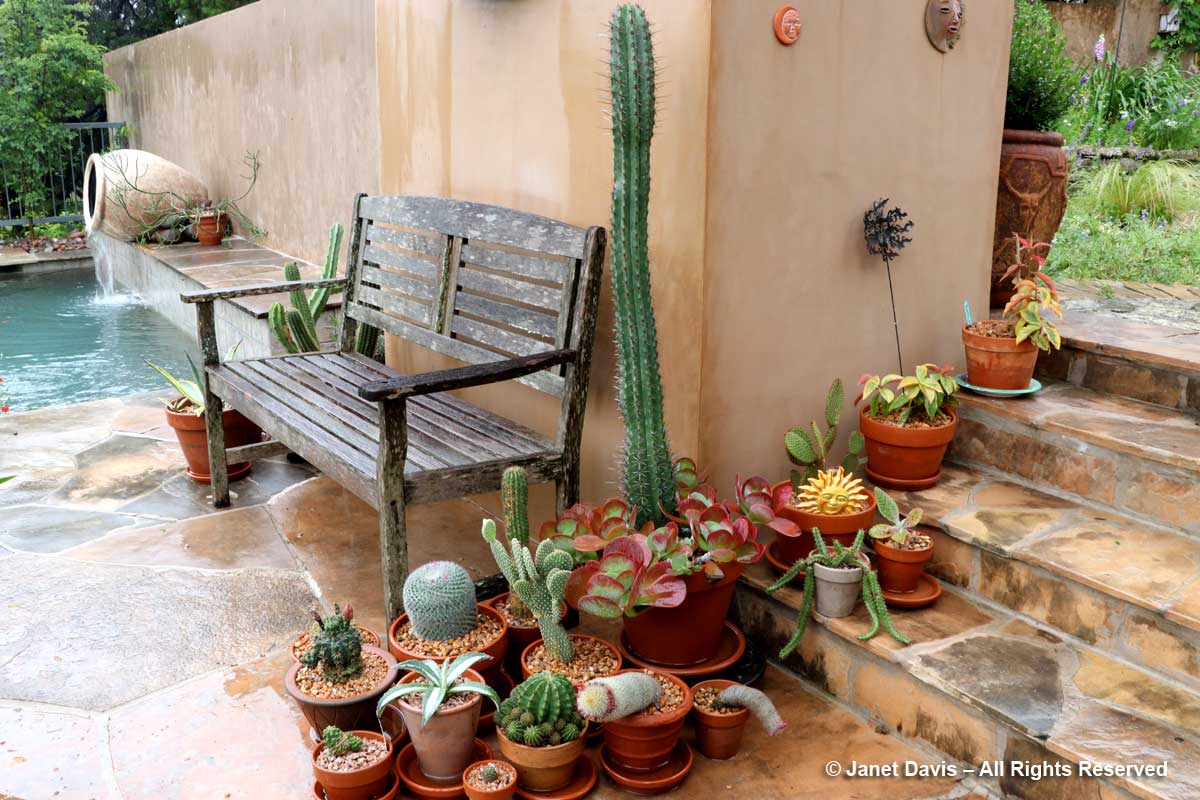
….. into the appropriately named sunken garden, aka the pool garden. This, for me, is the full embodiment of those glossy photos I loved in those books long ago. A true cottage garden filled with a mélange of romantic blossoms that will shift and alter their companions throughout the season. The iconic Texas bluebonnets are long-gone in this photo, but that’s how things start out here in April, which you can see in this photo by Jenny’s friend and our Austin Garden Bloggers Fling co-host Pam Penick’s post from April 2015.
Sometimes, in appreciating a grand design, I forget to notice the small details. Here’s the lovely native Texan golden columbine (Aquilegia chrysantha).
It was one of the cast of May characters in Jenny’s garden, along with annual love-in-a-mist (Nigella damascena), blue mealycup sage (Salvia farinacea), magenta-pink sage (Salvia sp.) As Jenny notes, “I rely heavily on self-seeding plants and am more than willing to let them grow where they plant themselves, as well as passalongs from garden friends. It’s not a low-maintenance garden.”
Most of the breadseed poppies (Papaver somniferum) had already formed their seedpods….
…. but corn poppies (Papaver rhoeas) were still announcing their brilliant presence. I loved the flowing urn feature here, which creates a bit of music with its splash.
What an inviting scene. Many gardens we saw in Texas were accompanied by a swimming pool, because as lovely as spring weather can be, summers are punishingly hot. And since there are no trees inside the garden walls and the rocks do reflect the sunshine, Jenny says the garden becomes very hot in midsummer. The walls here, by the way, are not just decorative, but meant to keep out varmints, including deer.
Here’s another look at the flowery poolside meadow. This area was originally laid with old granite flagstones, so the Stockers laid Arizona sandstone on top leaving 1-inch spaces for self-seeding plants.
You can see in the background against the wall one of the large, porous limestone boulders native to the property.
There are native cacti in the gardens, including the spineless prickly-pear (Opuntia cacanapa ‘Ellisiana’).
I found Jenny in the sunken garden, chatting with fellow bloggers (her own interesting blog is called Rock Rose) and looking mightily relieved that the morning’s rain had stopped in time for our visit.
I waited for my blogging pals to take their leave of this beautiful dining area near the swimming pool – one of six seating areas Jenny and David use, depending on the time of year and day – so I could make my photo. There’s a good reason for being the last one on the bus!
At the edge of the dining area was another grouping of containers, this one featuring the agave relative Manfreda undulata ‘Chocolate Chips’.
Manfreda flowers are so interesting, especially post-Texas-rain.
The herb garden is tucked into an alcove created by the house walls, and looks beautifully wild..
Nearby, behind the wall of the swimming pool garden, sits the potager: a series of raised beds containing…..
… leafy vegetables like curly kale……
….and squash vines starting out under protective wiring….
….and tomato cages.
A long raised bed nearby contains flowers for pollinators. In early May, it abounds with larkspur (Consolida ajacis) and Verbena bonariensis.
Perfumed star jasmine (Trachelospermum jasminoides) blankets one wall of a garden shed in this area. How nice it must be to harvest veggies with that scent wafting by!
A galvanized water tank is a great idea for a water garden: small, manageable maintenance, yet a nice spot for a bird to bathe or have a sip of water.
Nearby were little vignettes, like this…..
….. and this. For me in Toronto, Mexican feather grass (Nassella tenuissima) is a textural annual, but here it’s perennial and adds a grace note to the garden.
As always on a garden tour, the bus was waiting to take us to our next stop, so off we went in our rain-soaked shoes down the pathway beside the spineless prickly-pears. But for me, the garden of Jenny and David Stocker had been a chance to satisfy a long-held desire to enjoy time in a cottage garden filled with masses of flowers arrayed with artful abandon.

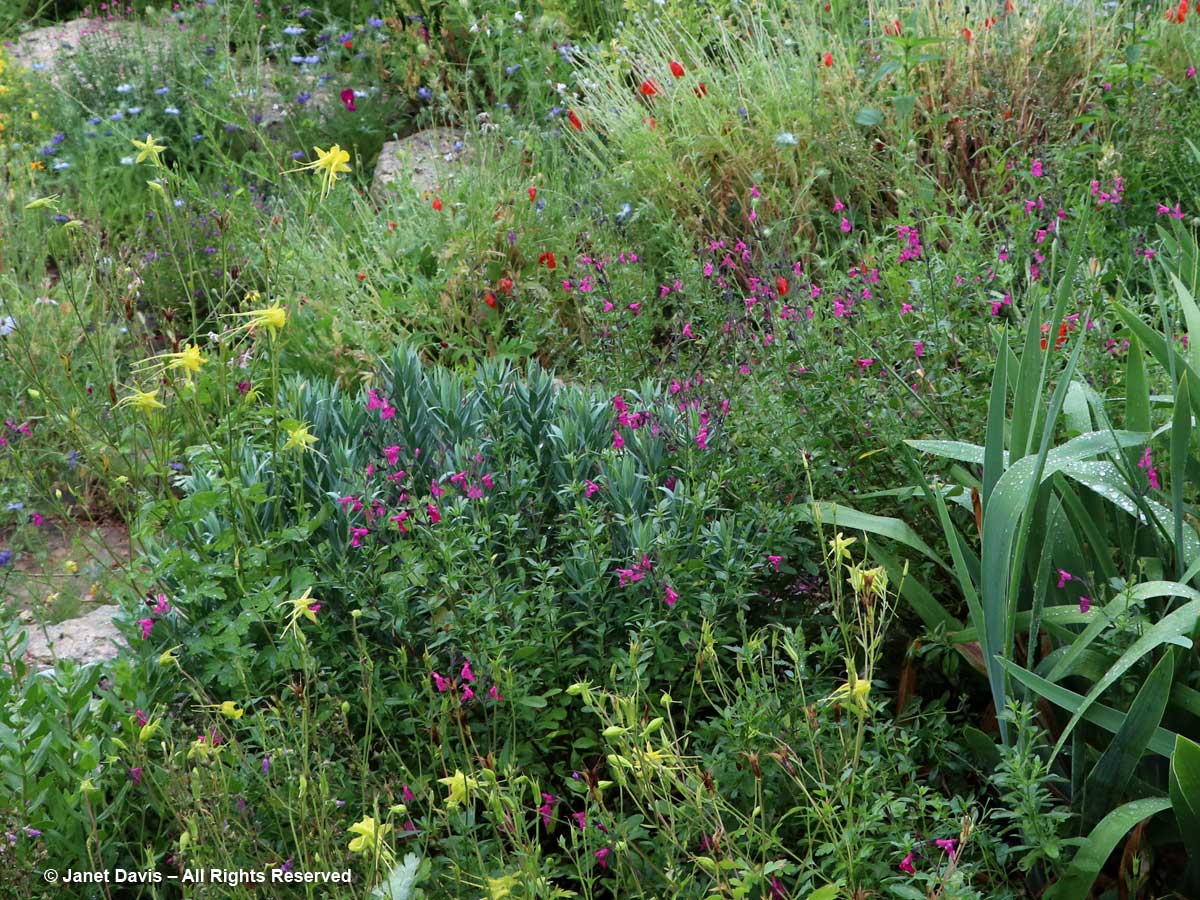
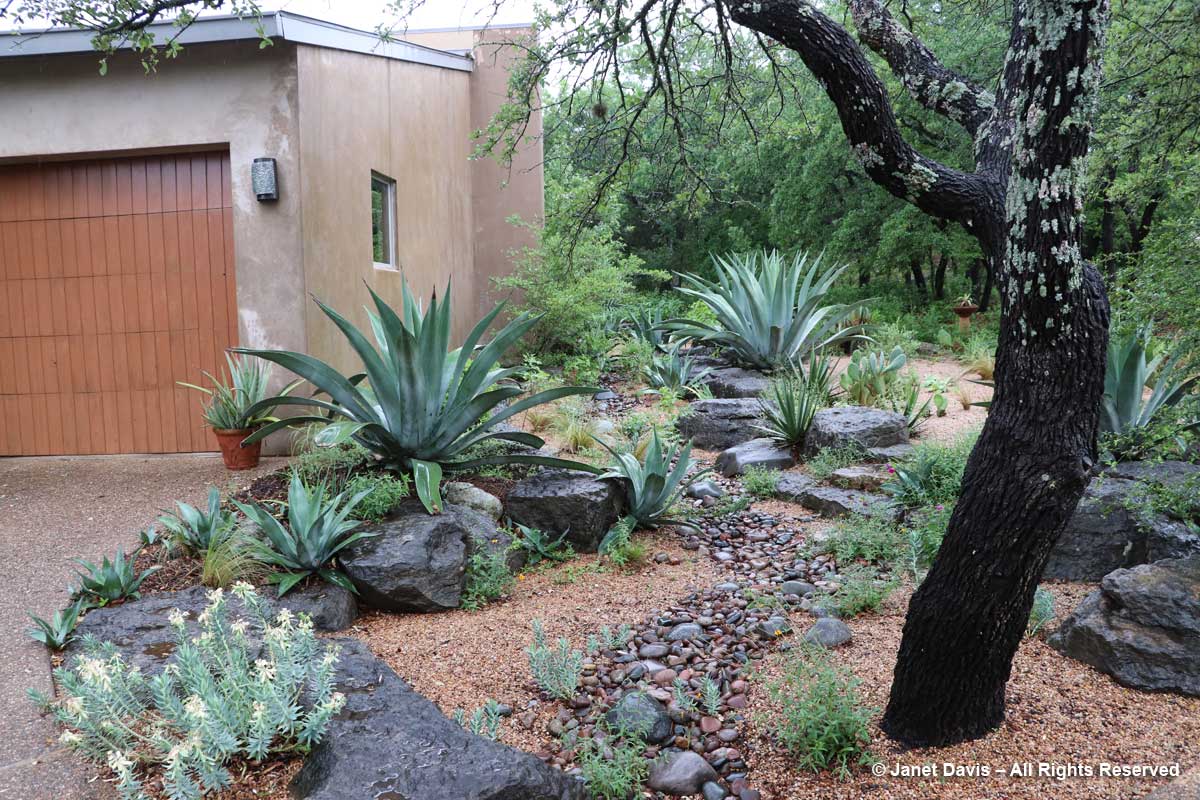
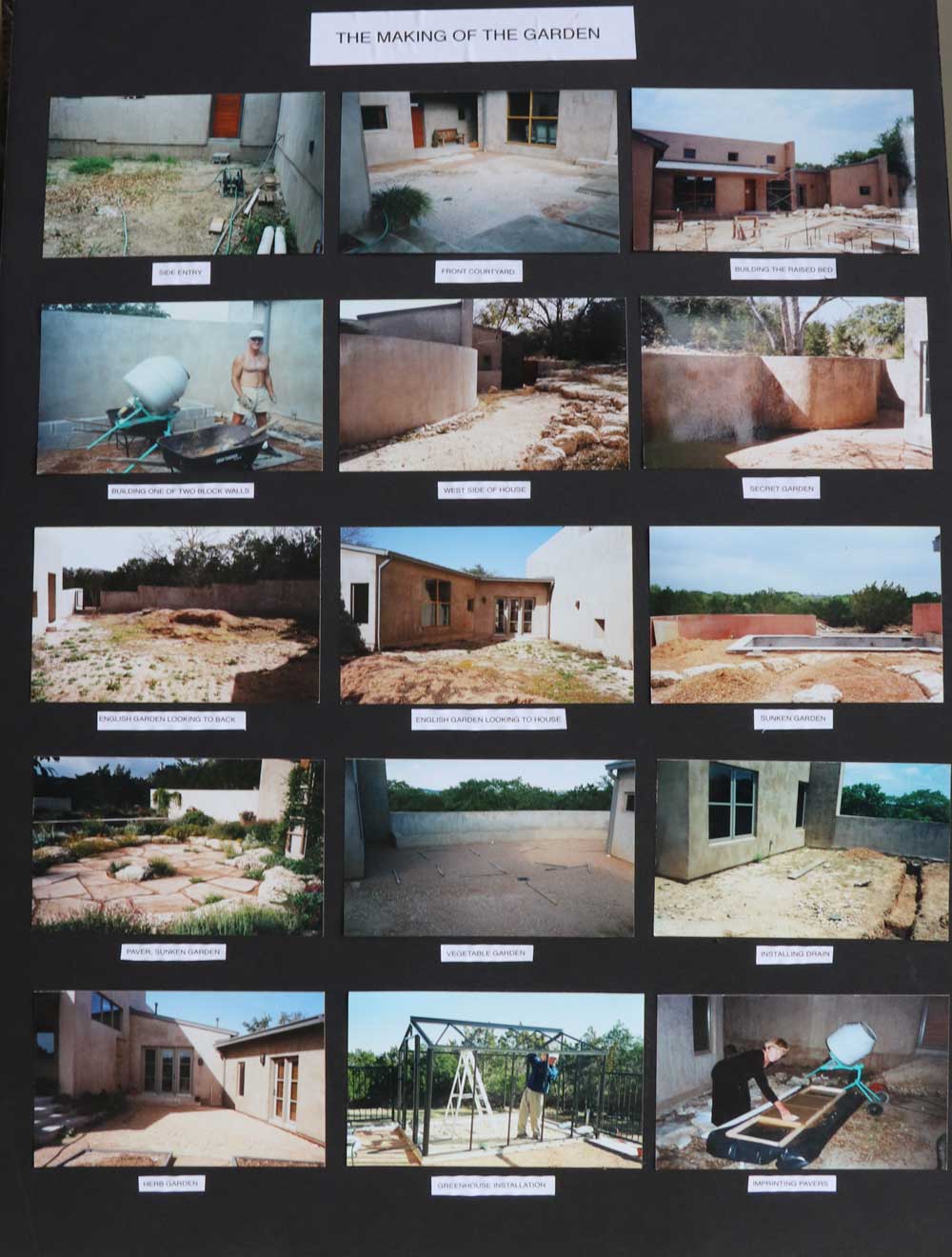

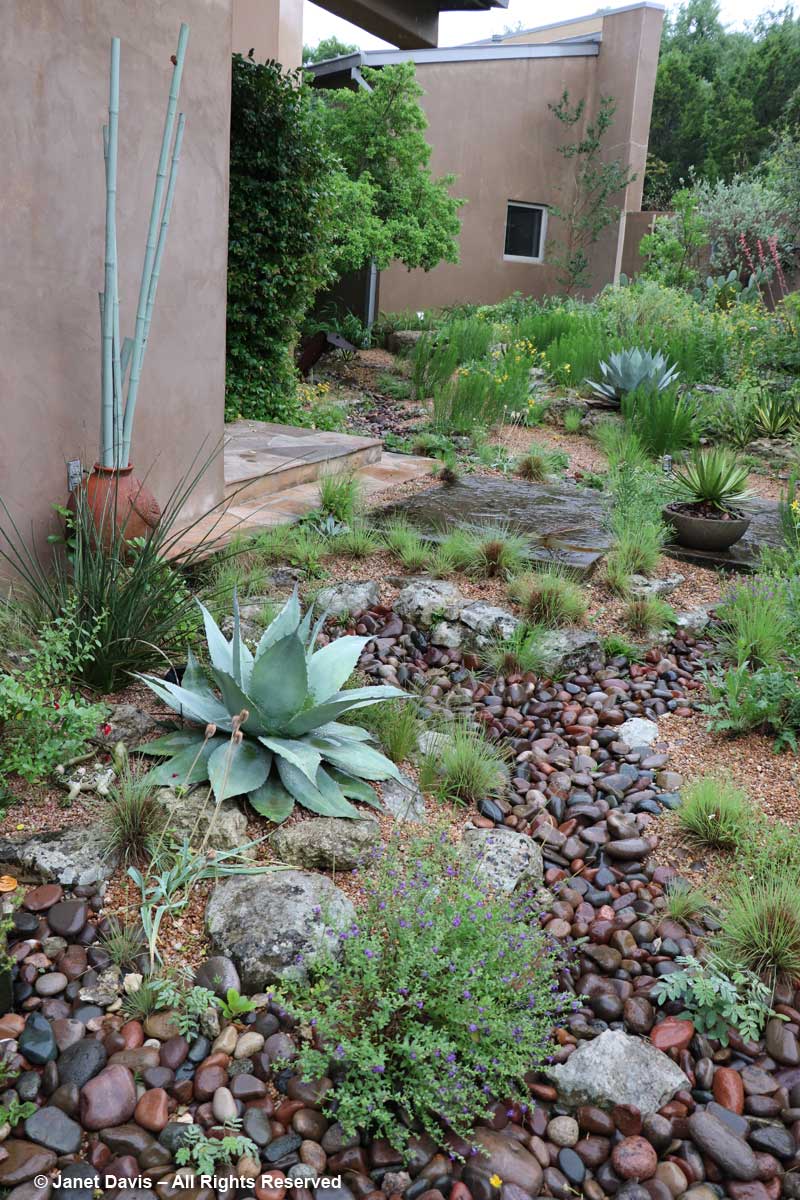
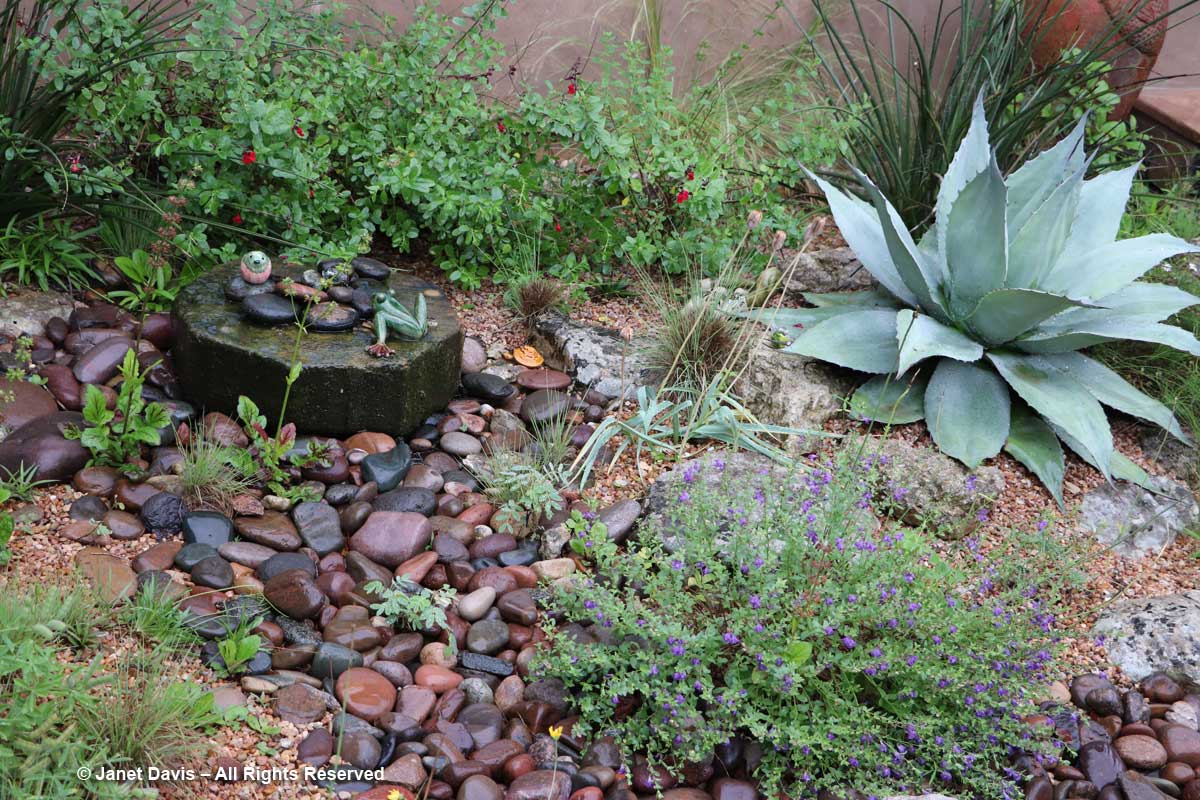
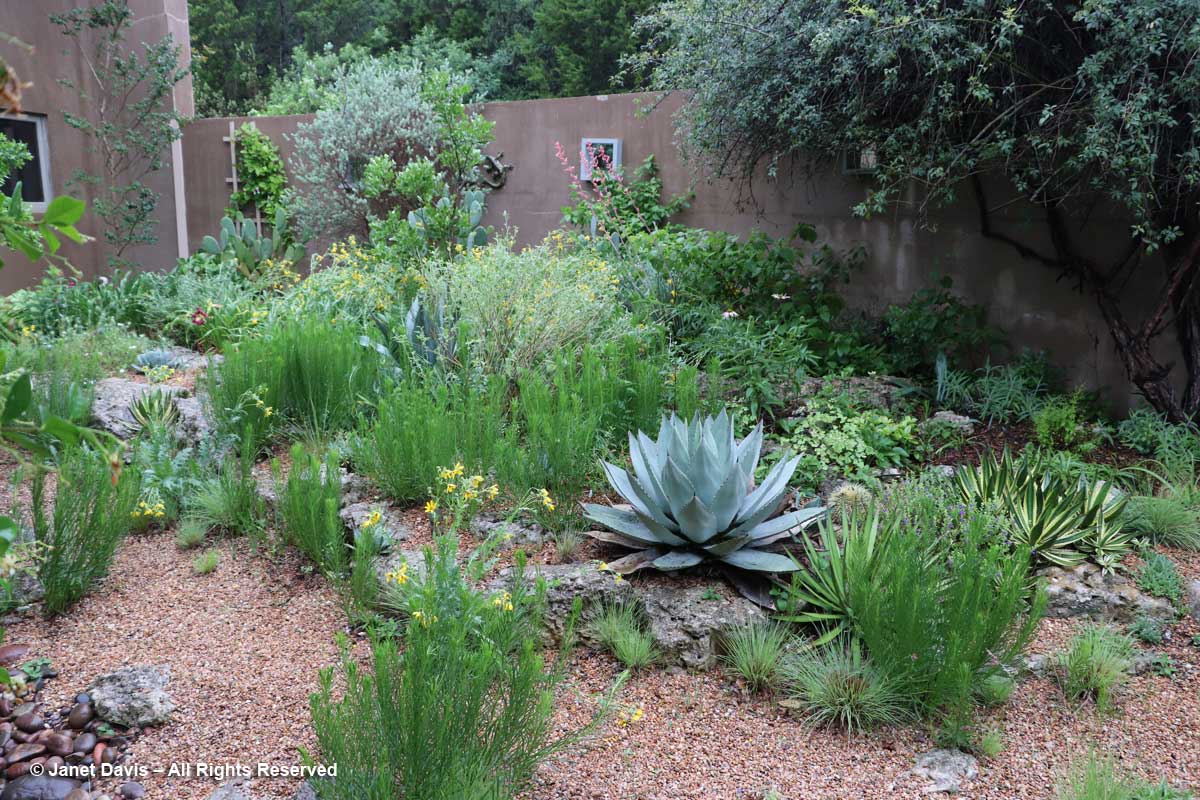
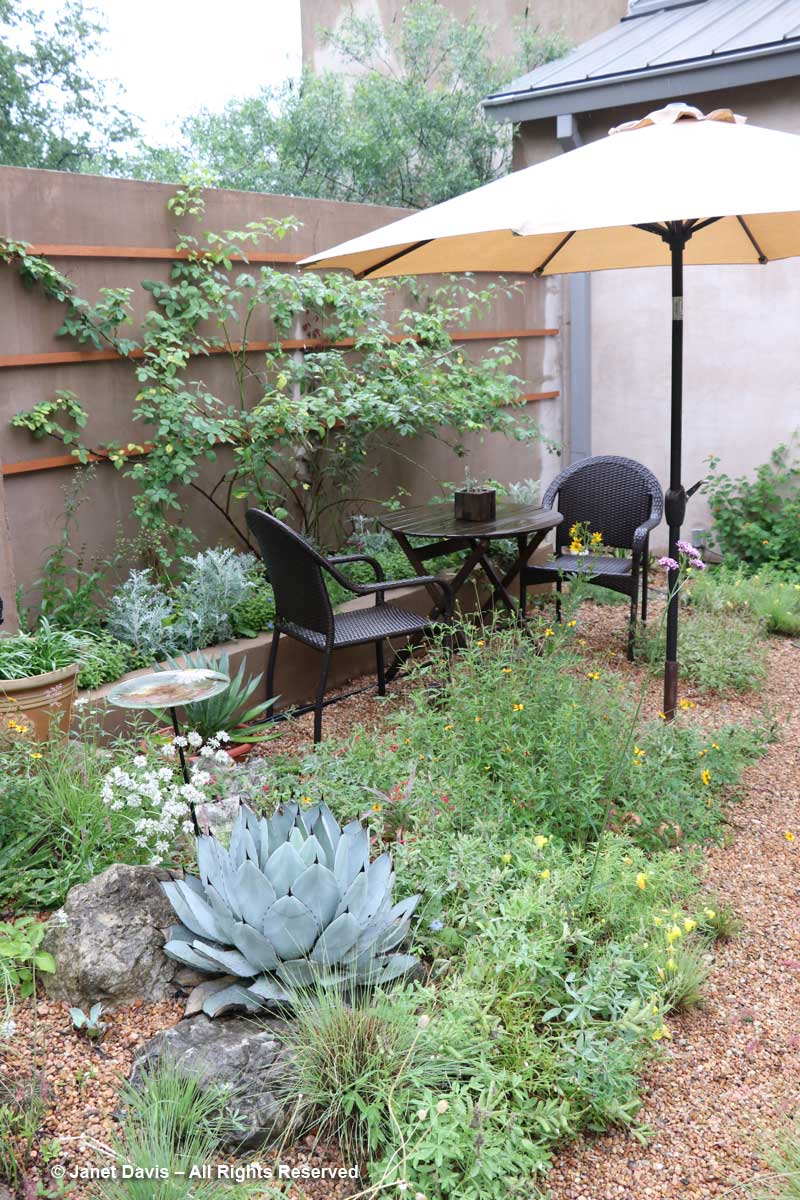
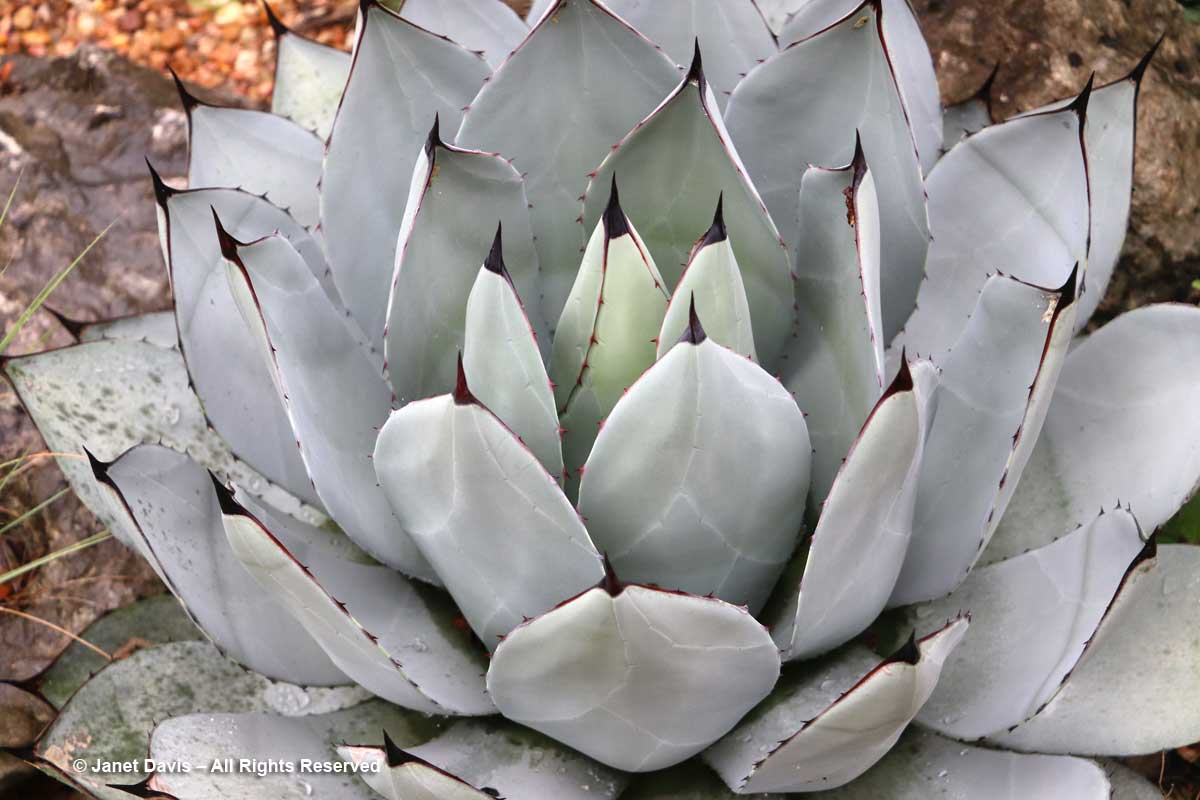
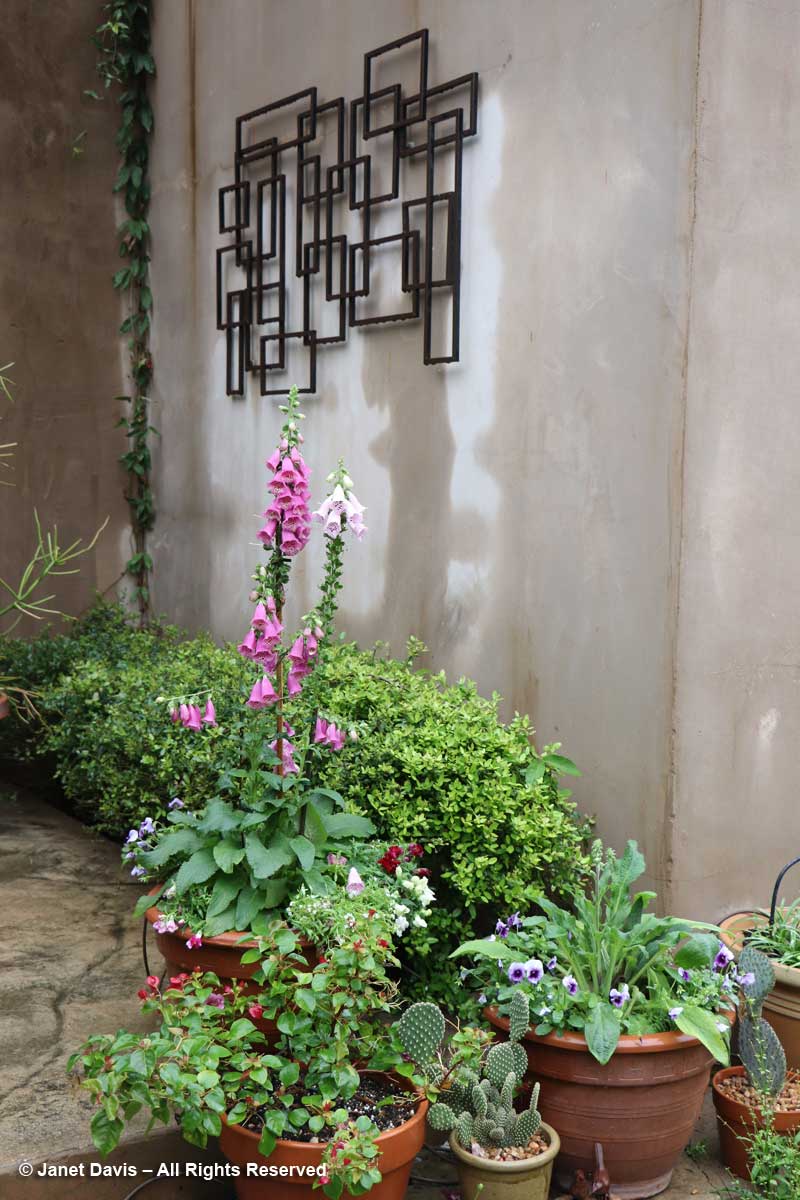
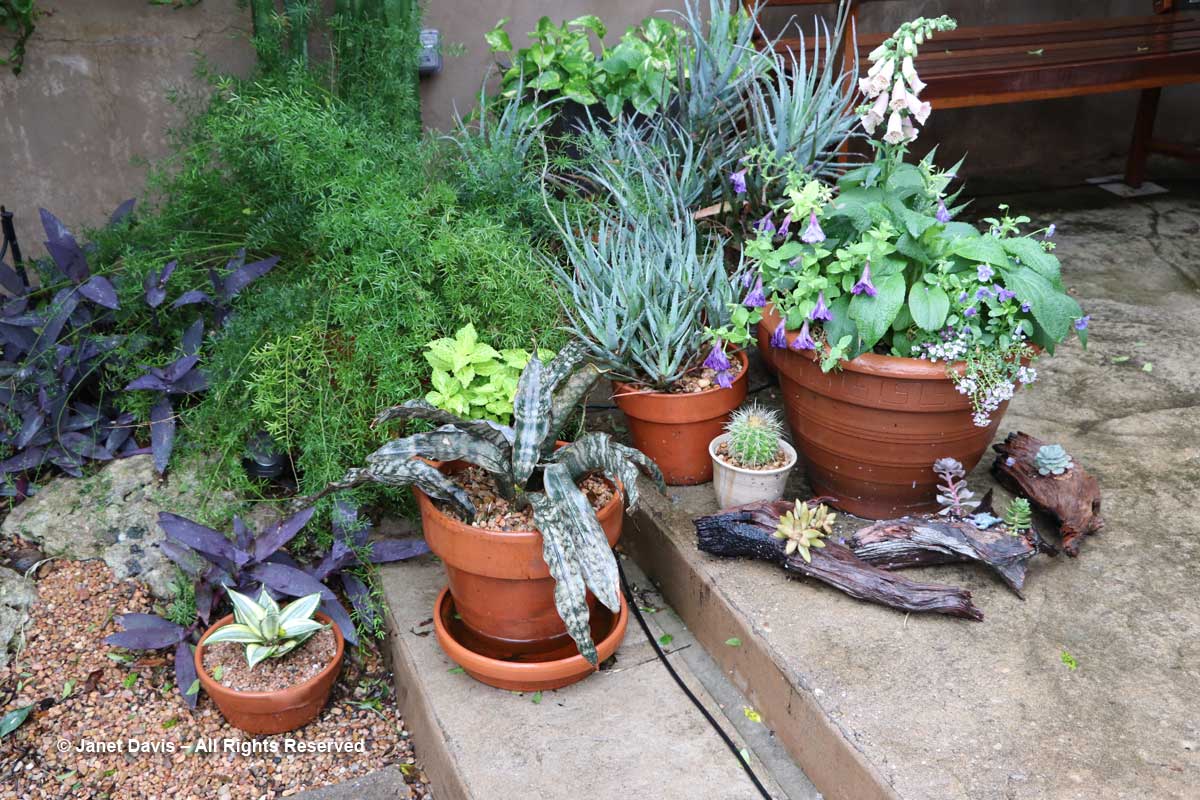
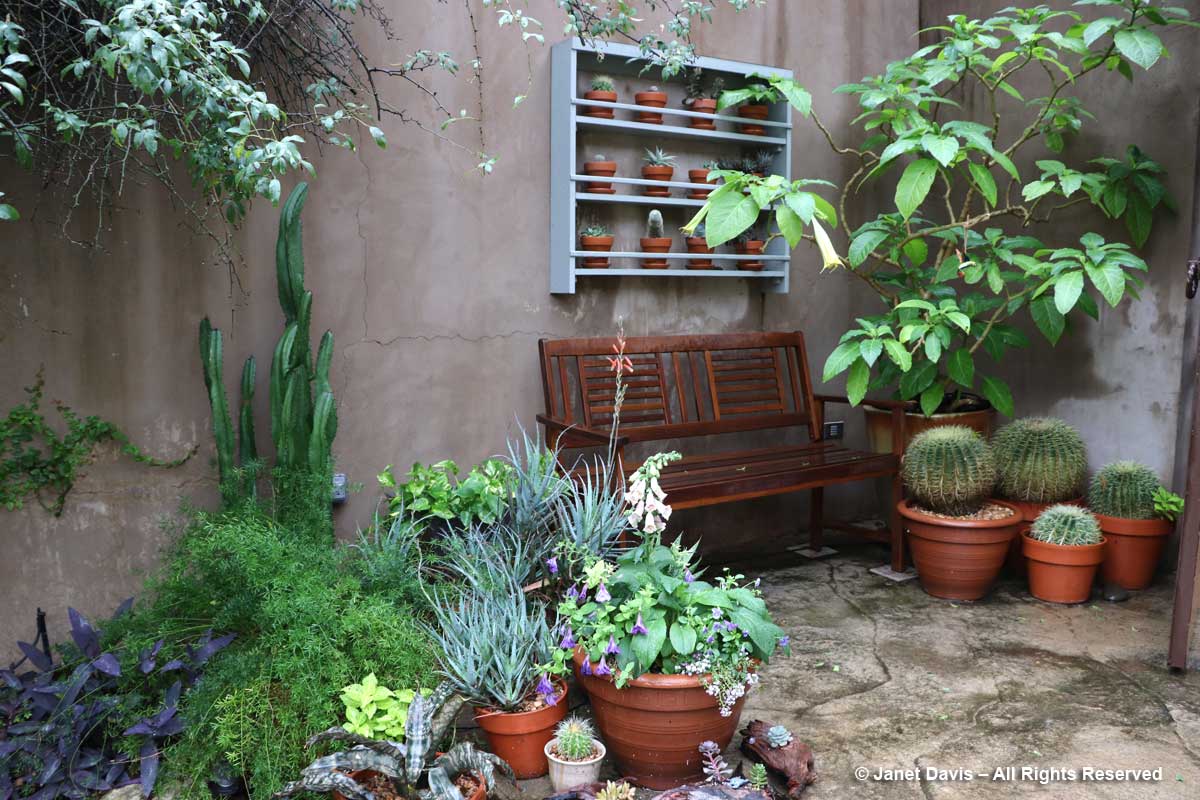
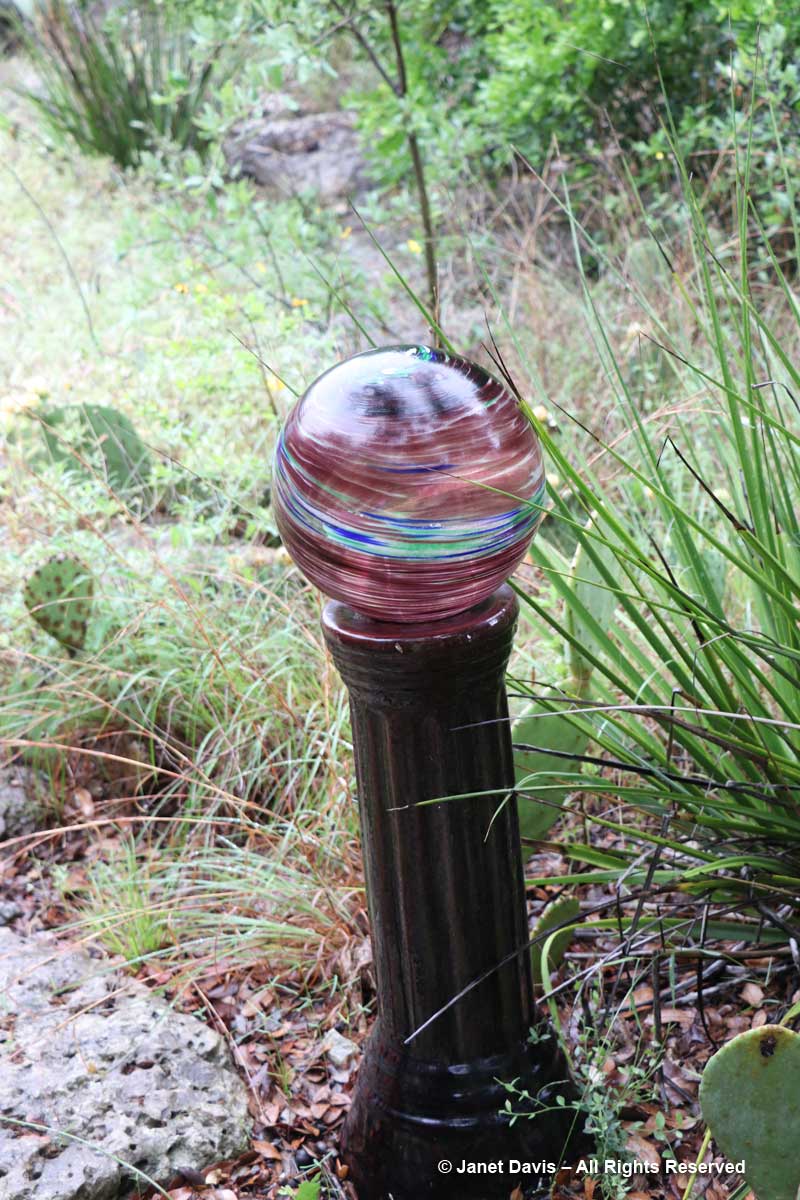
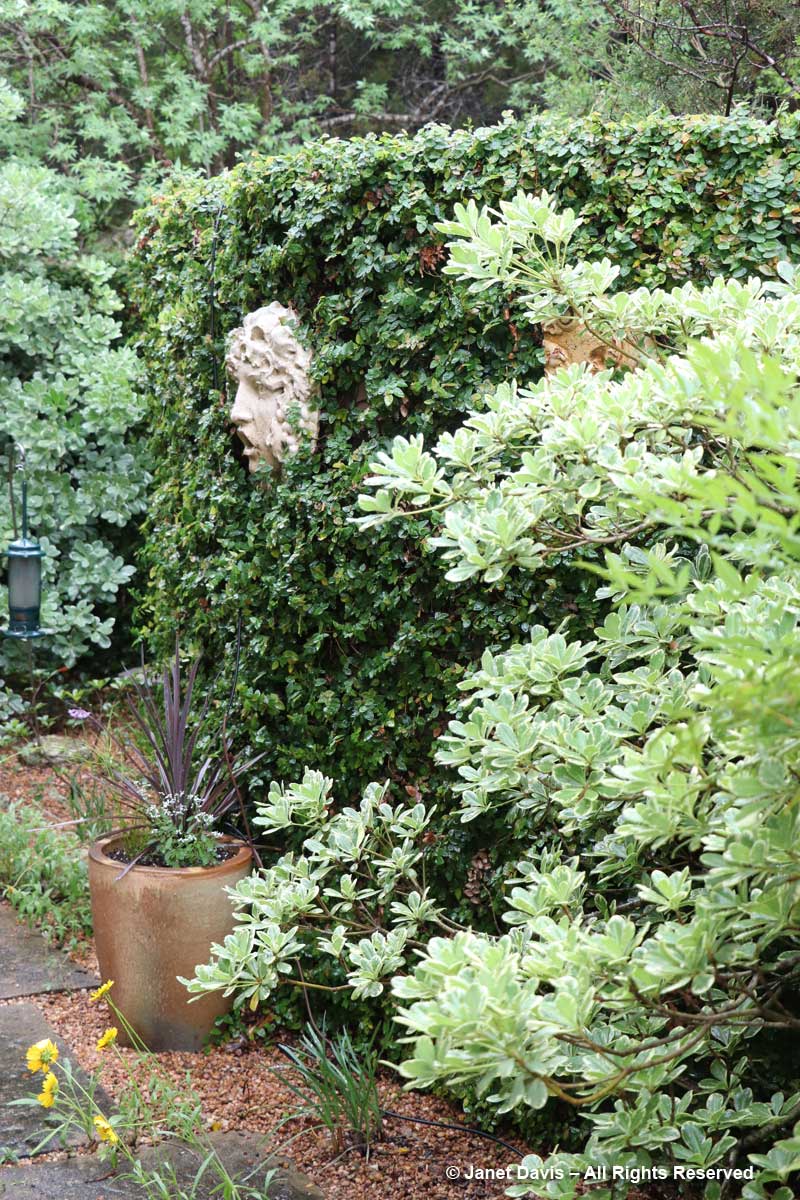
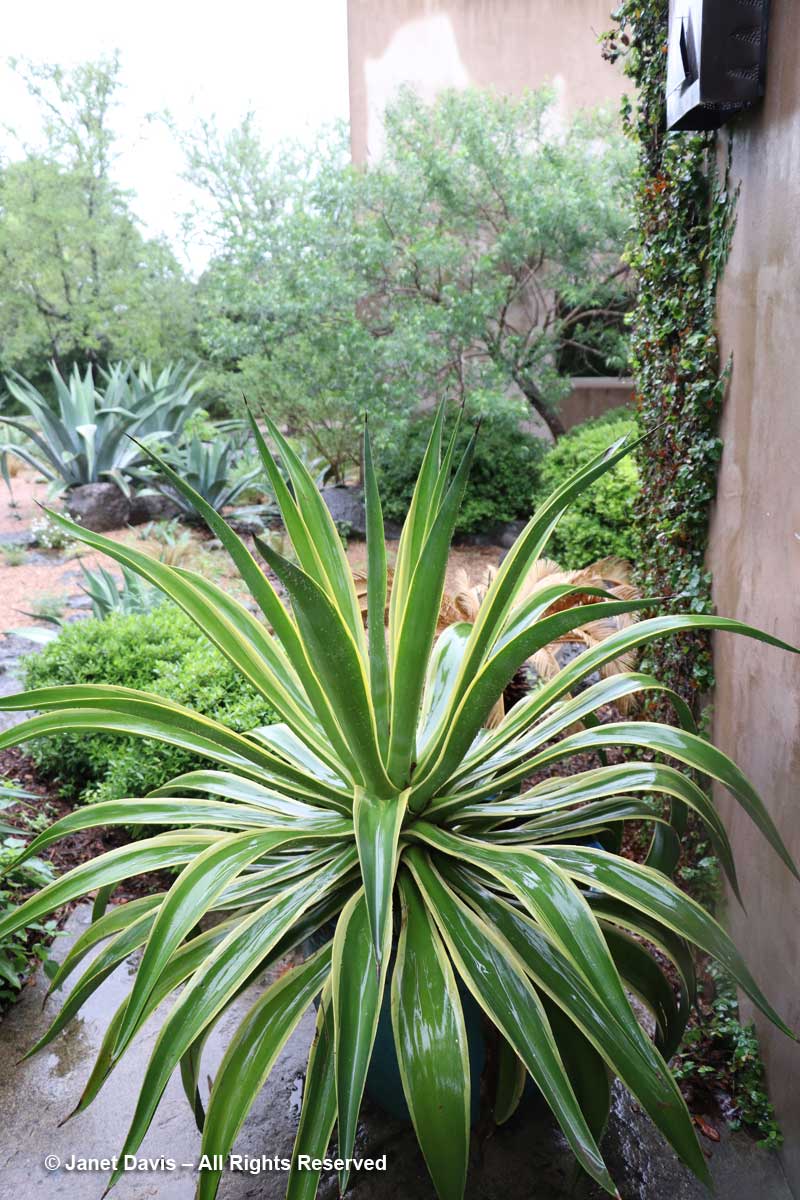
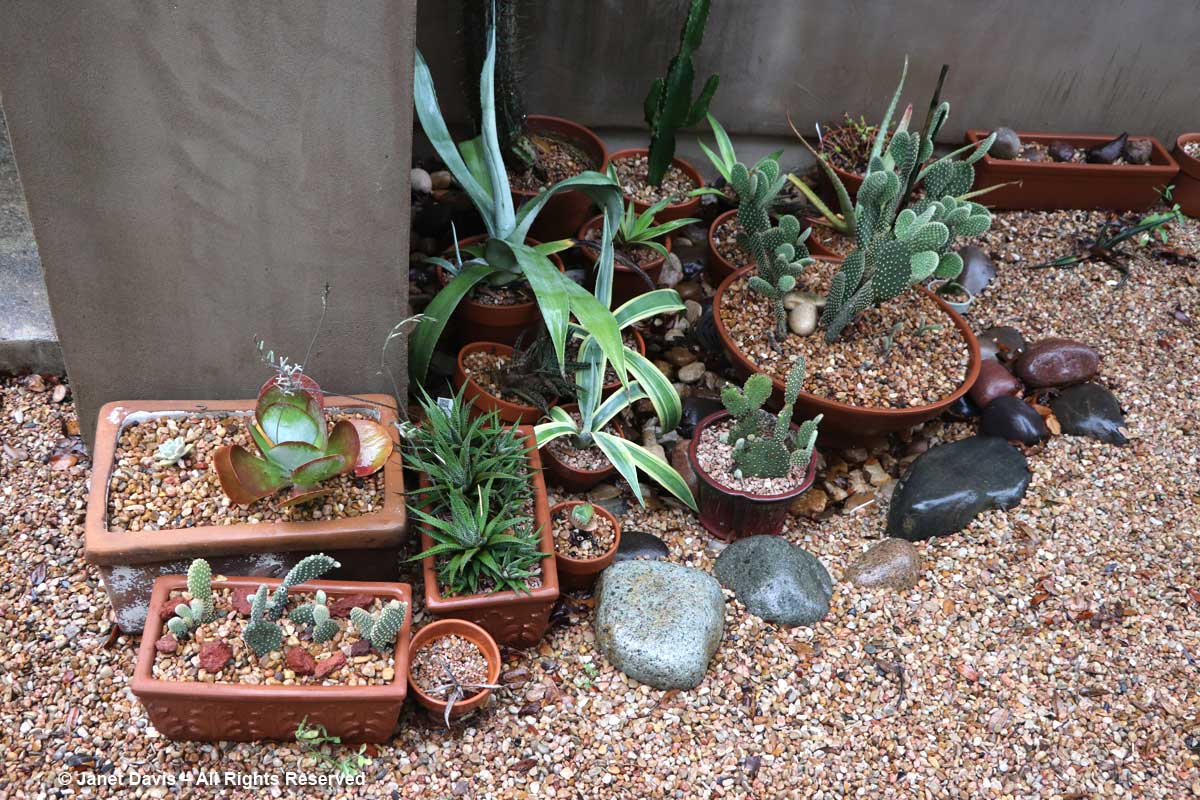
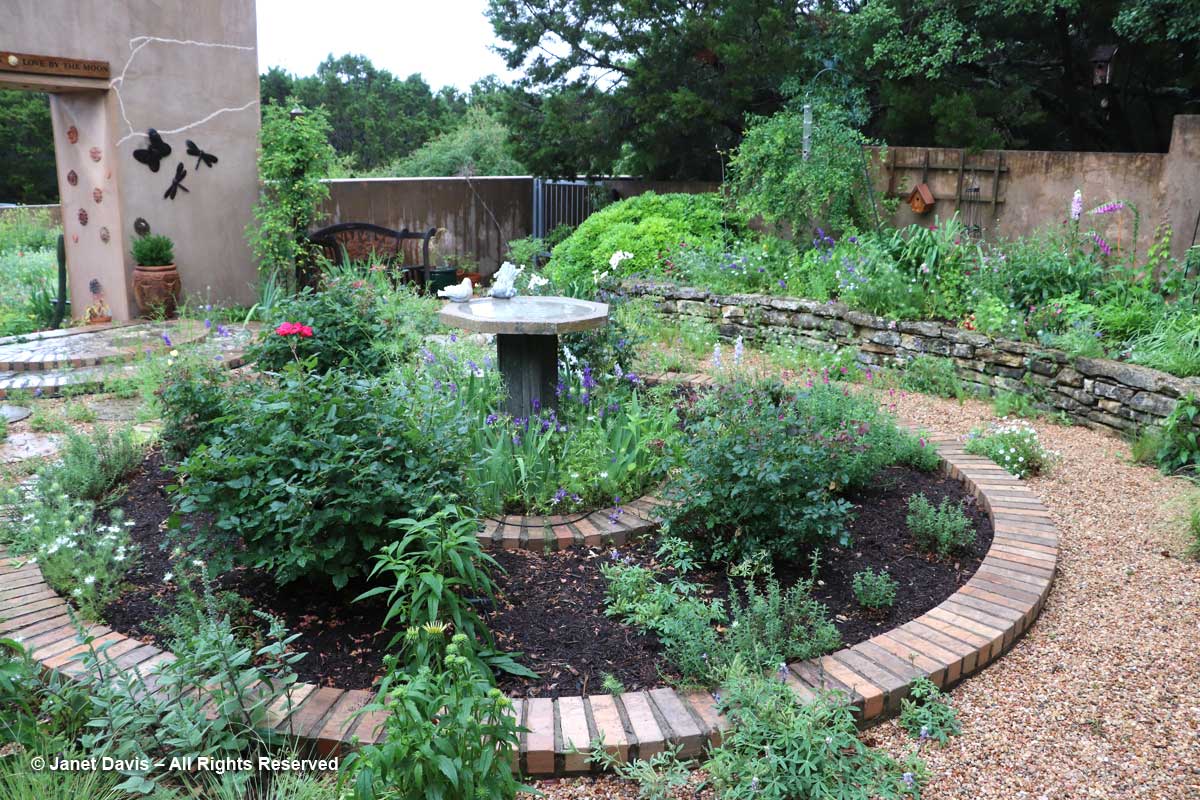
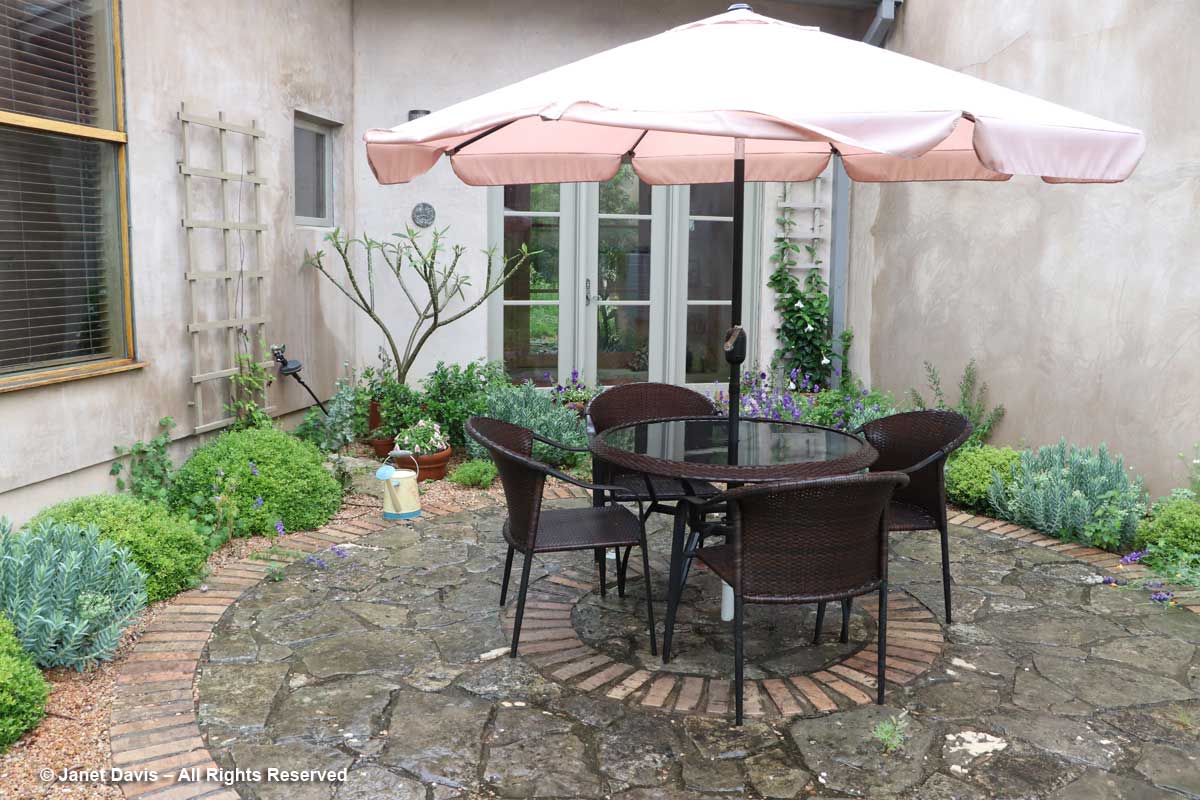
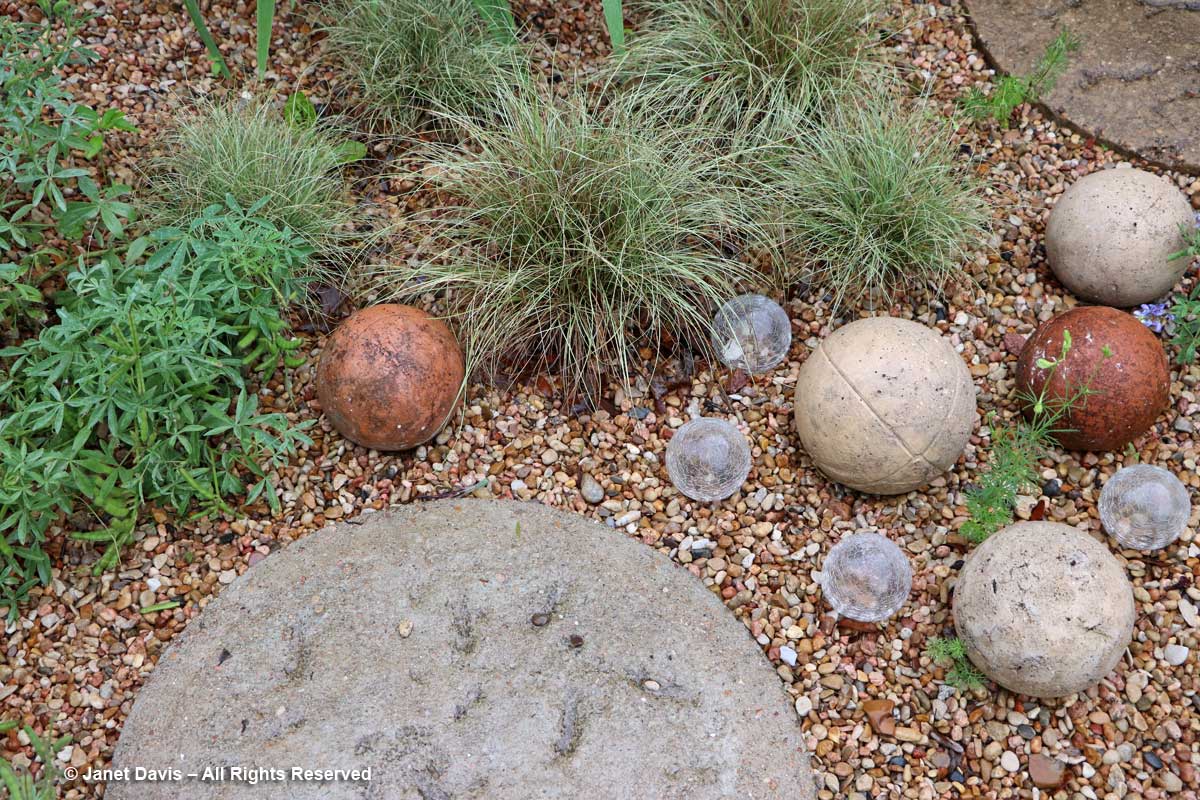
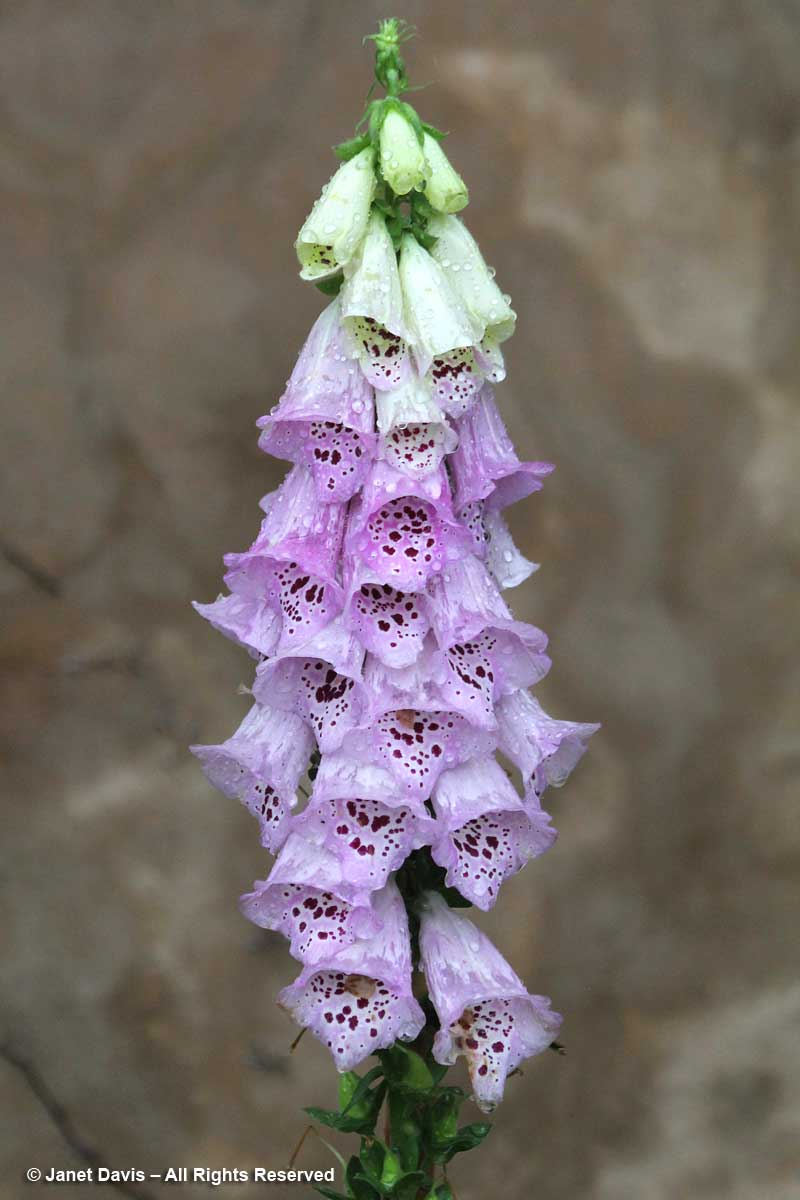
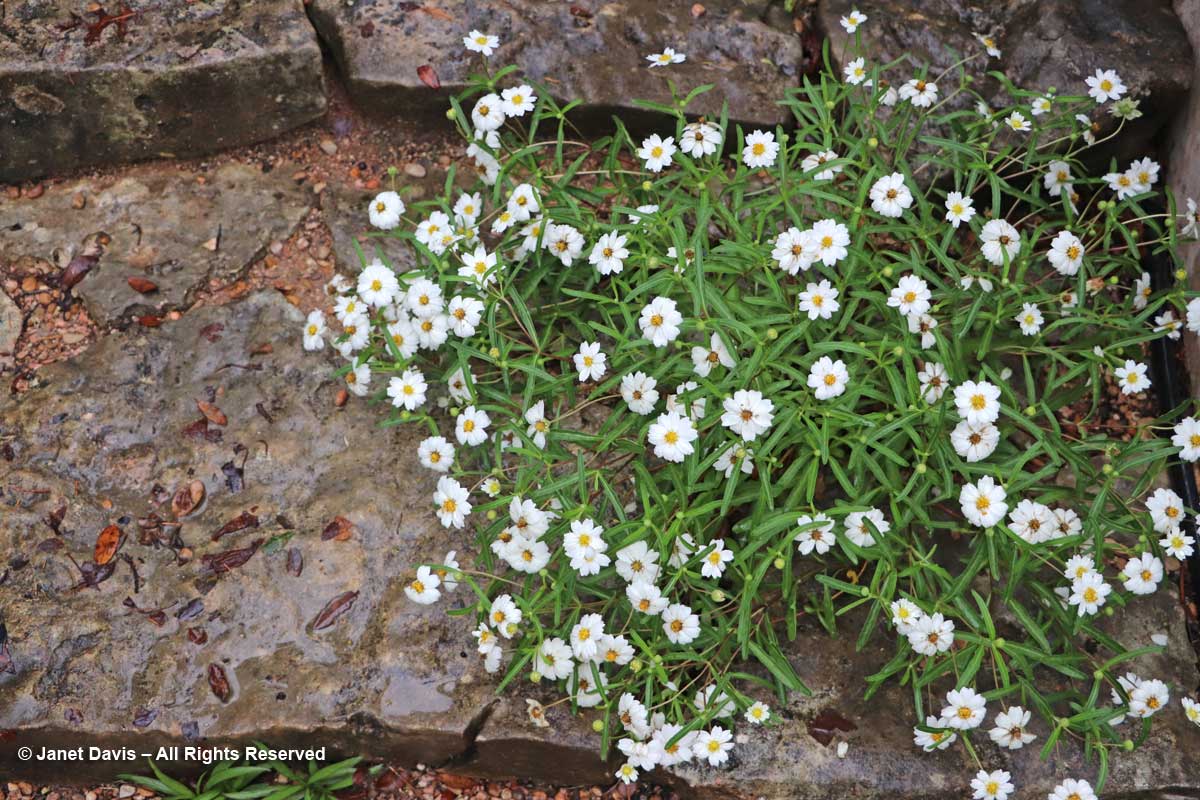
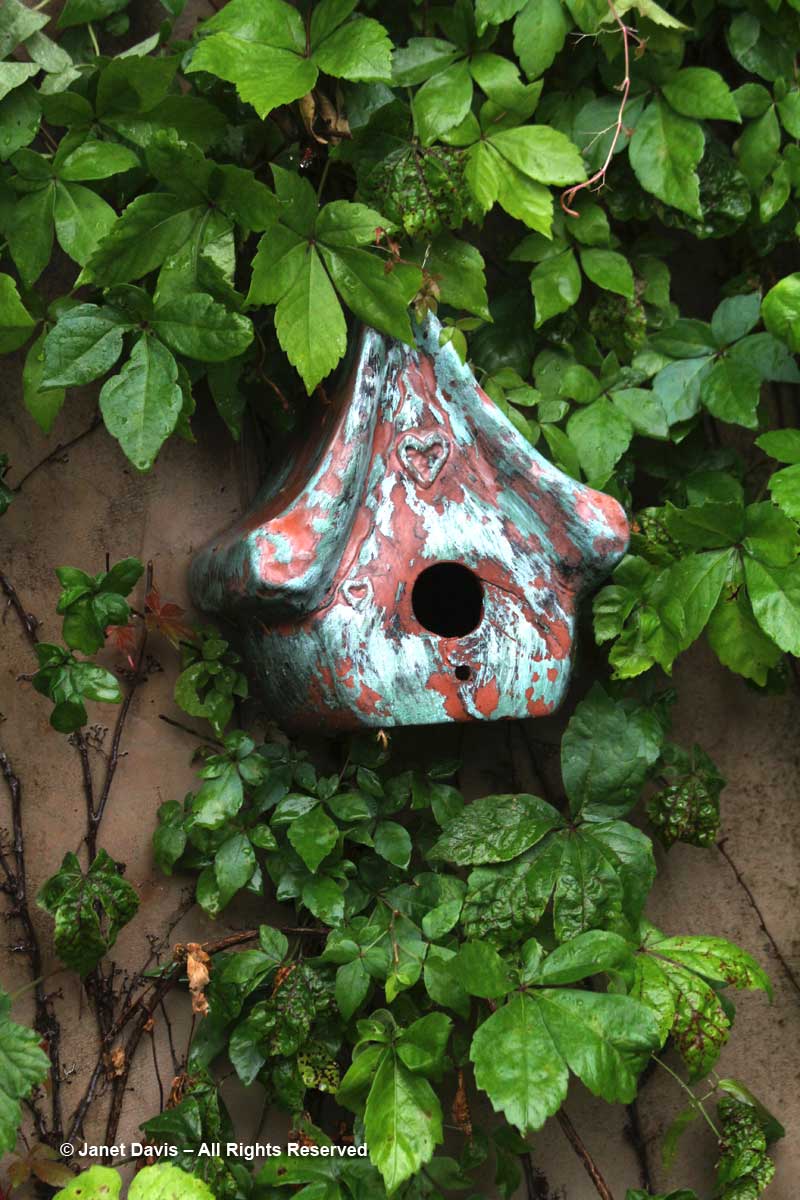
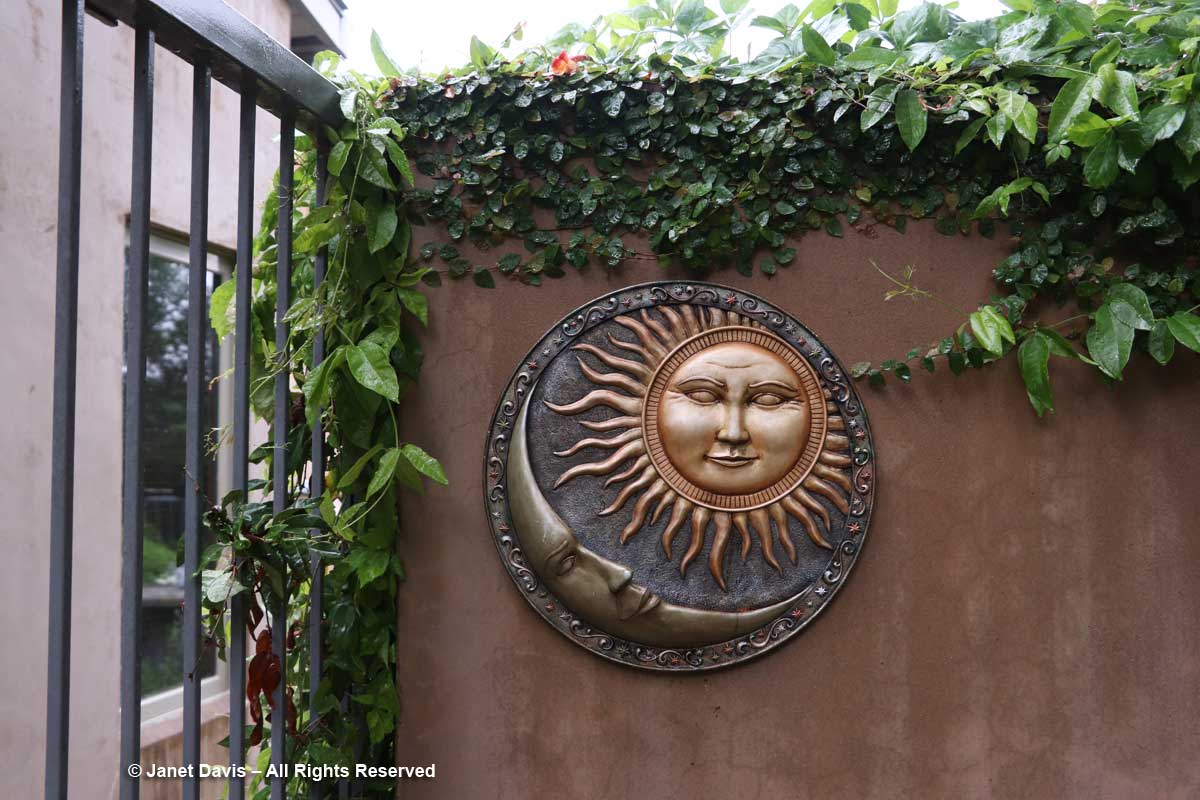
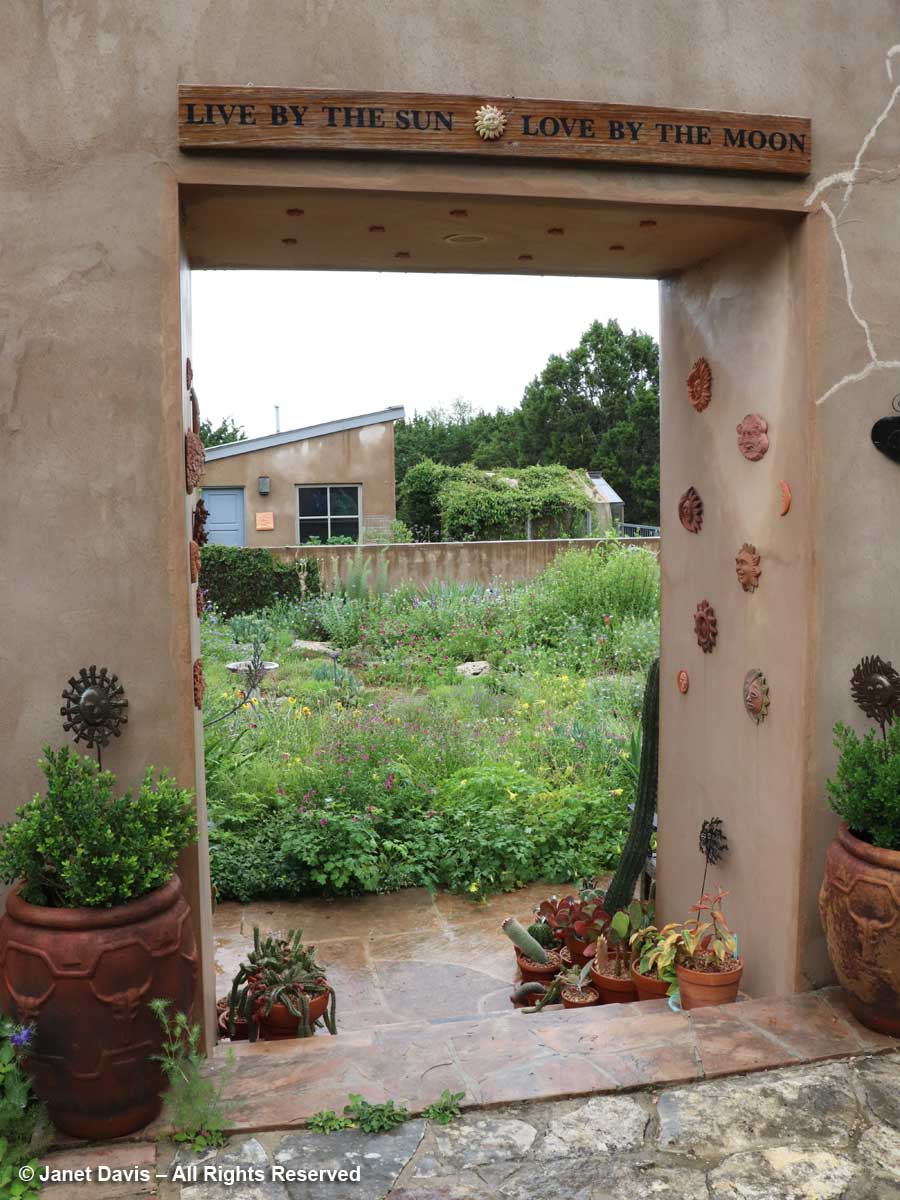
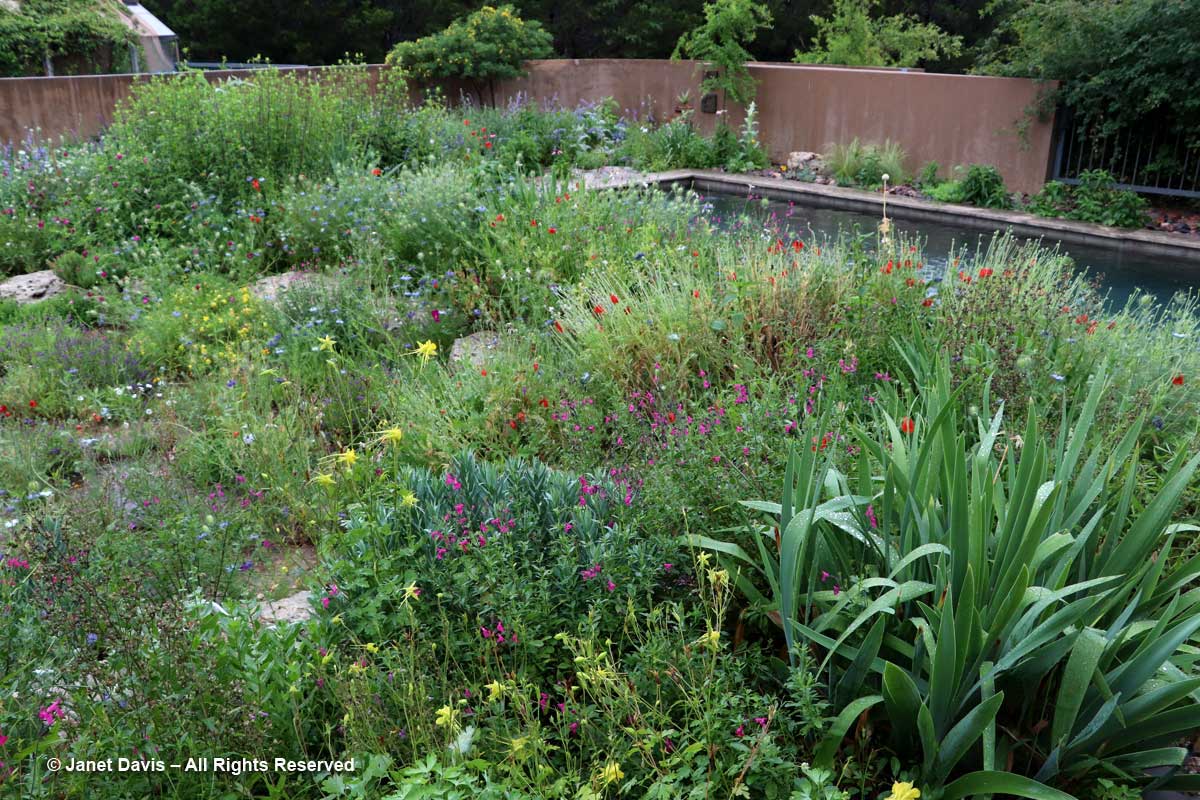
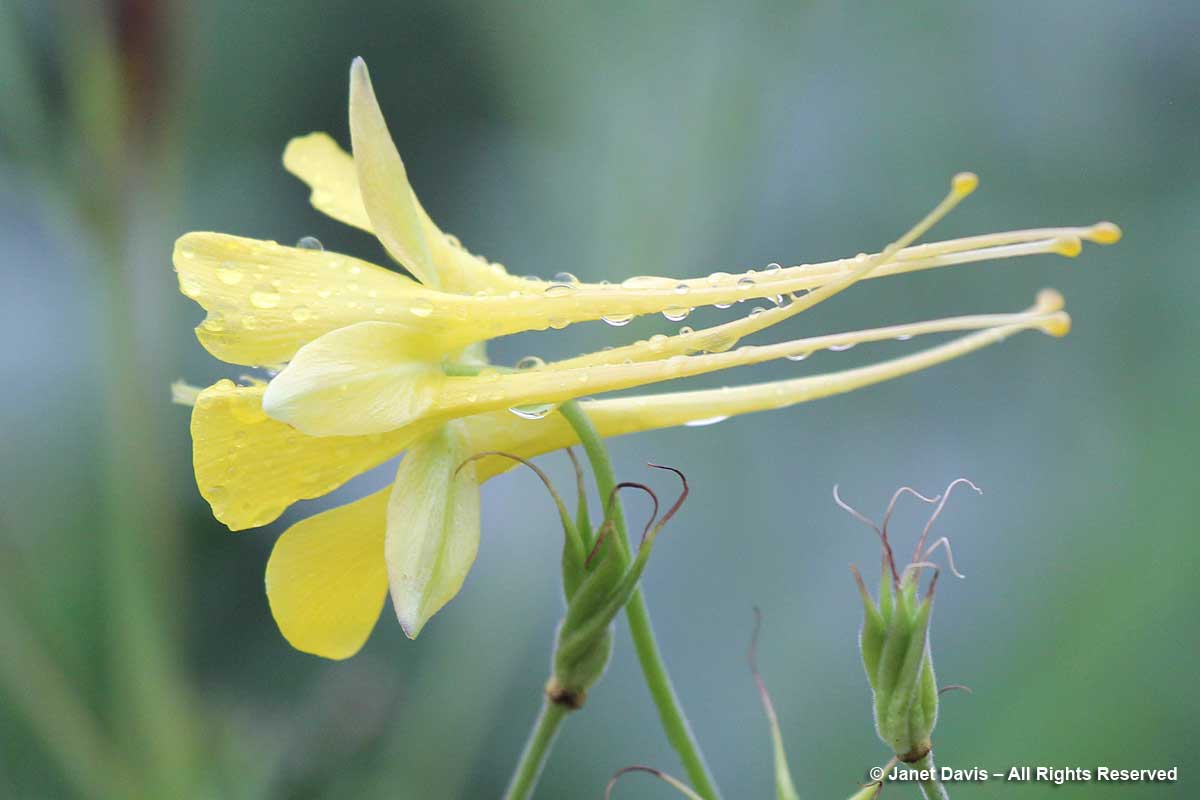
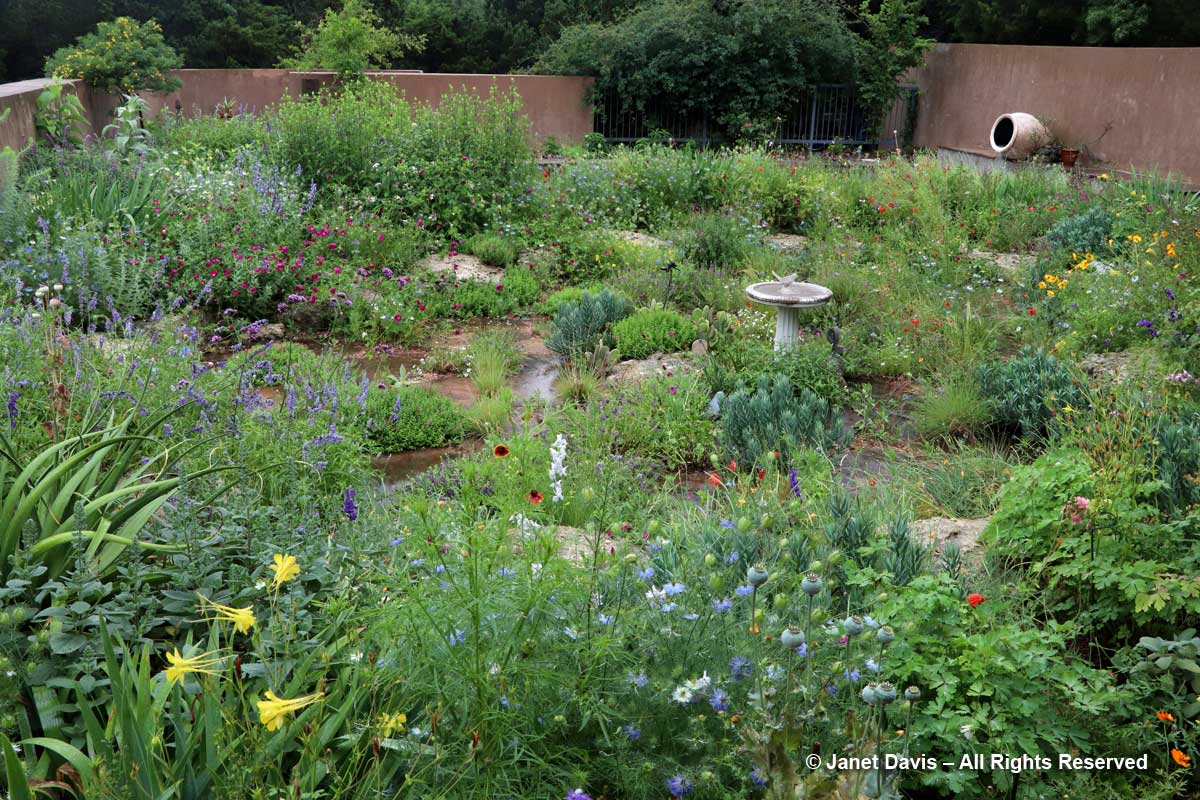
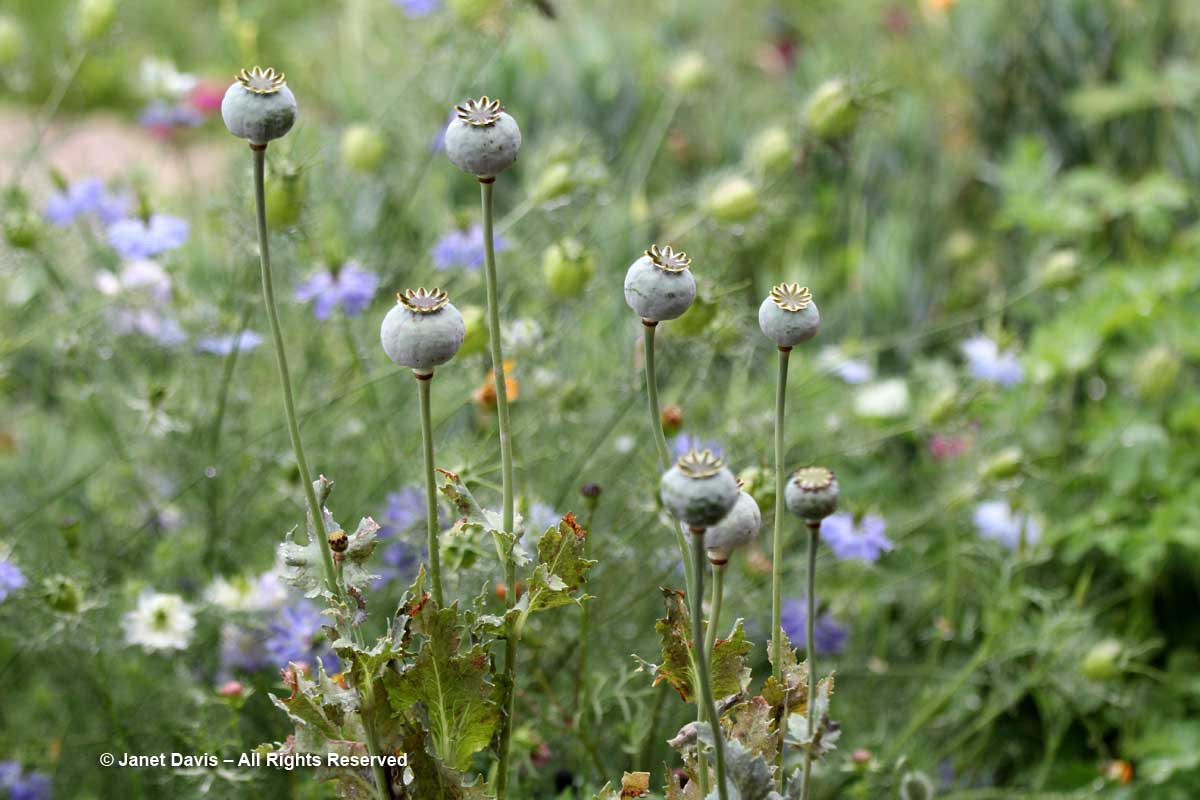
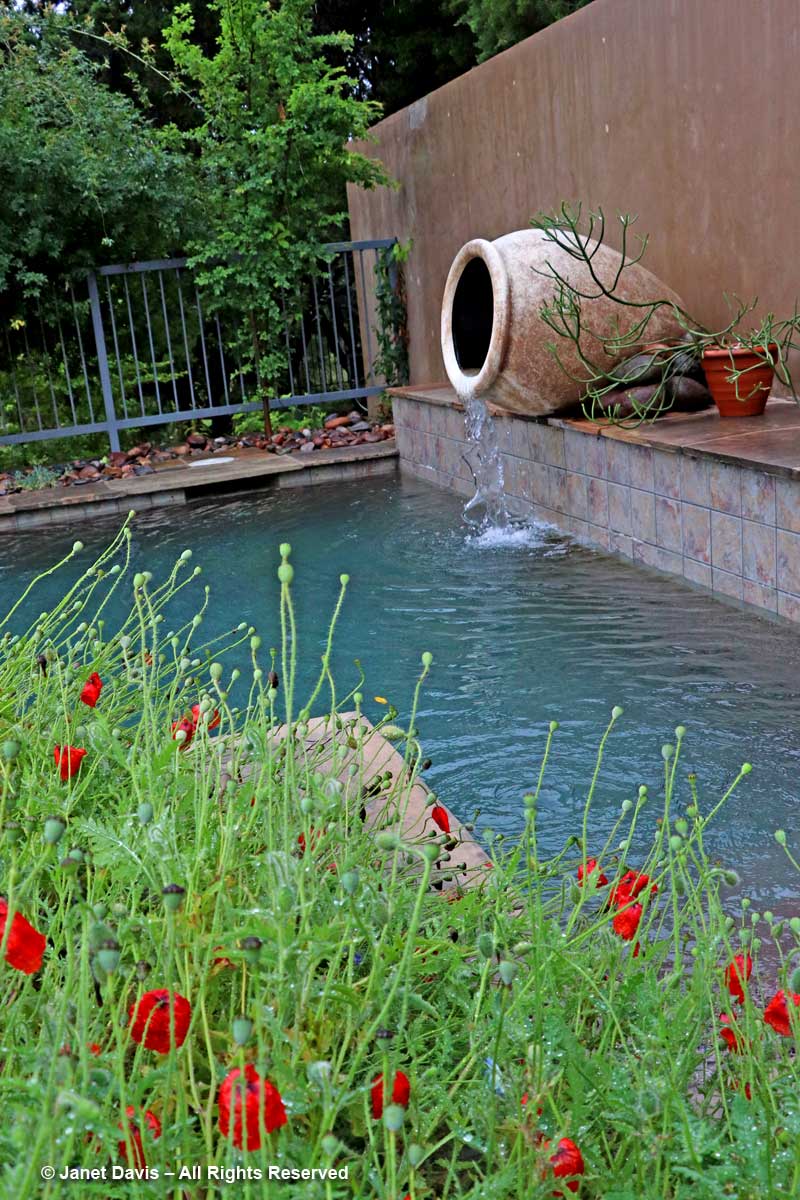
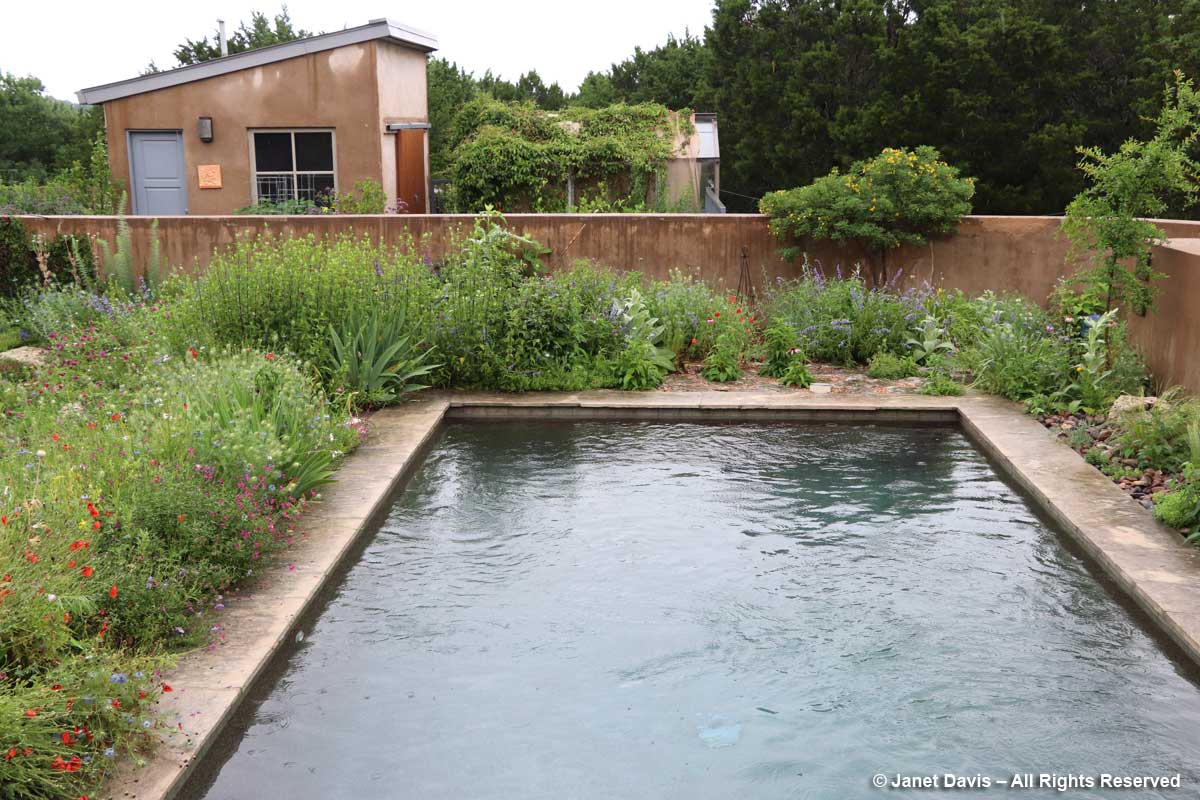
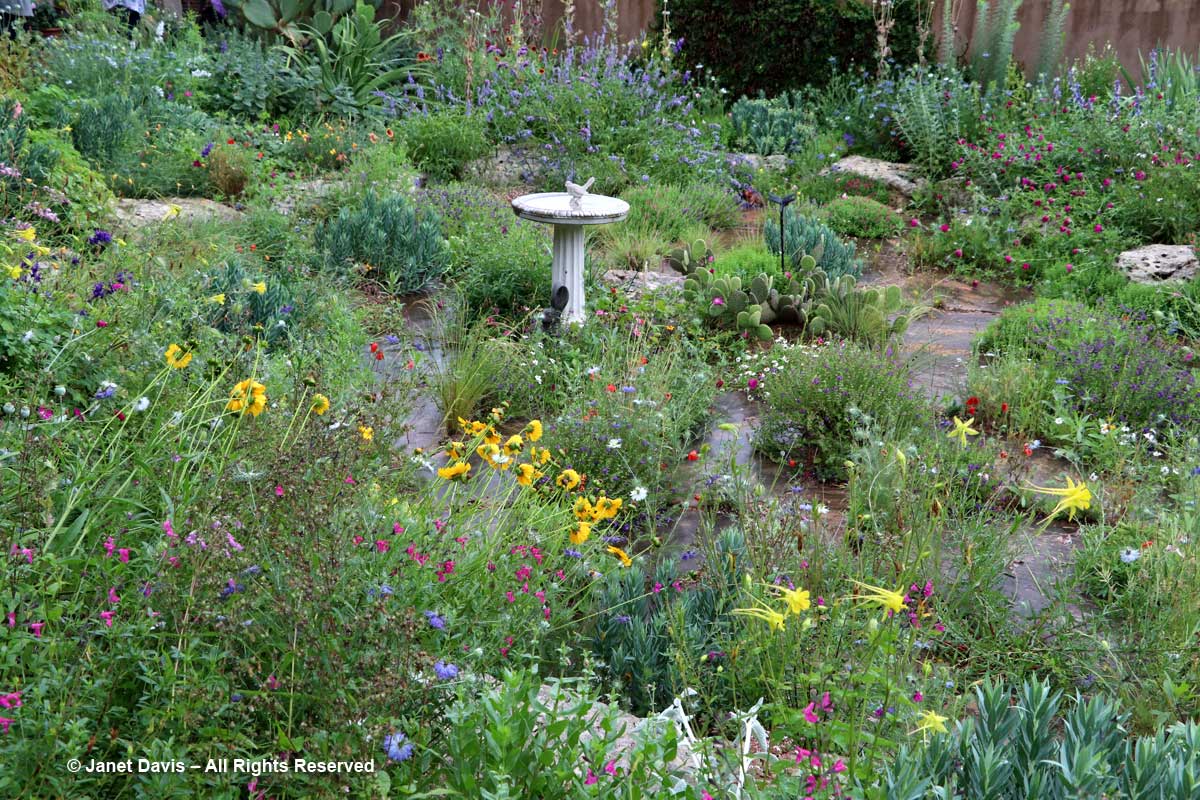
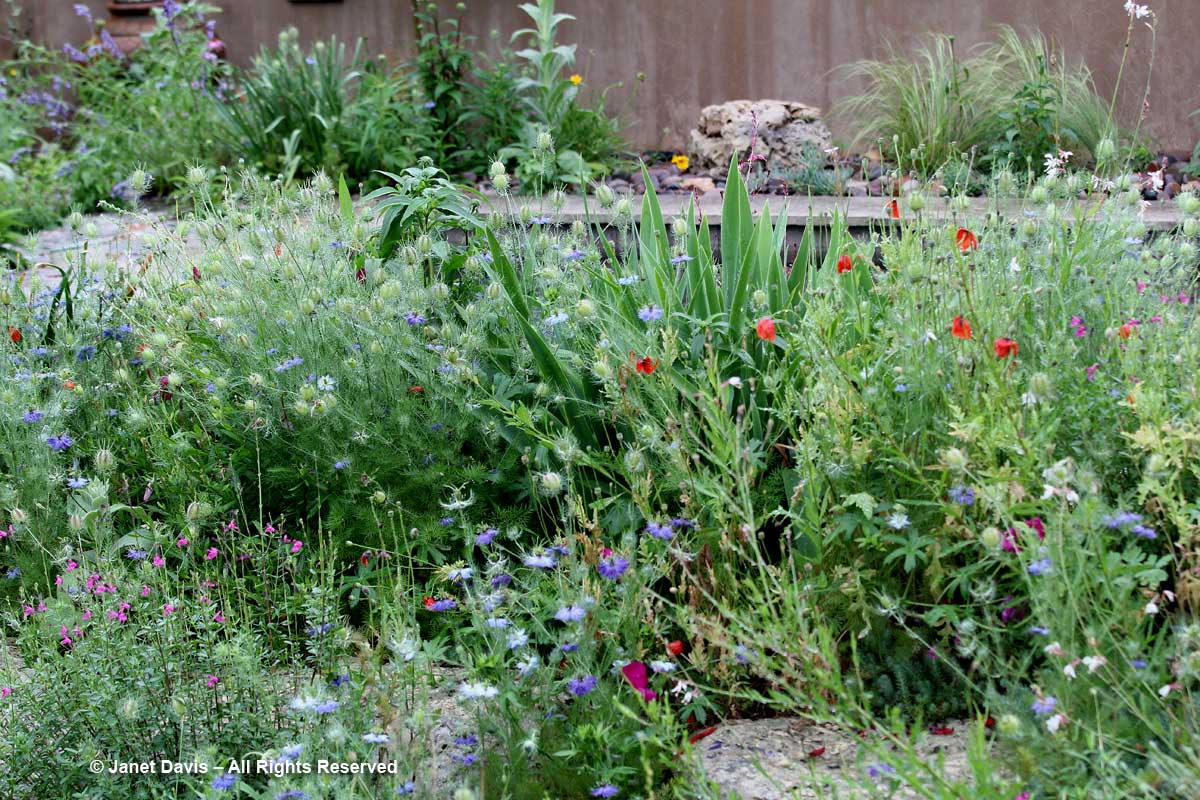
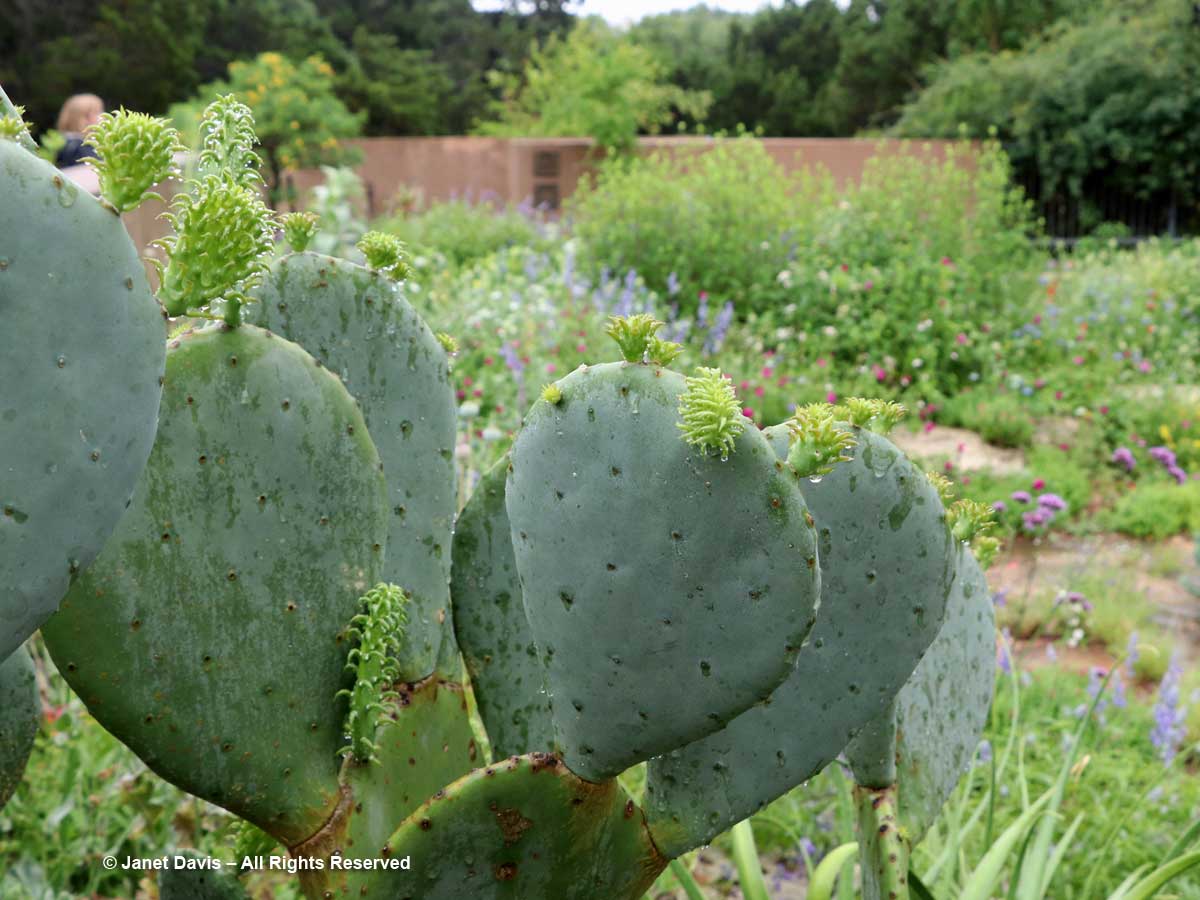
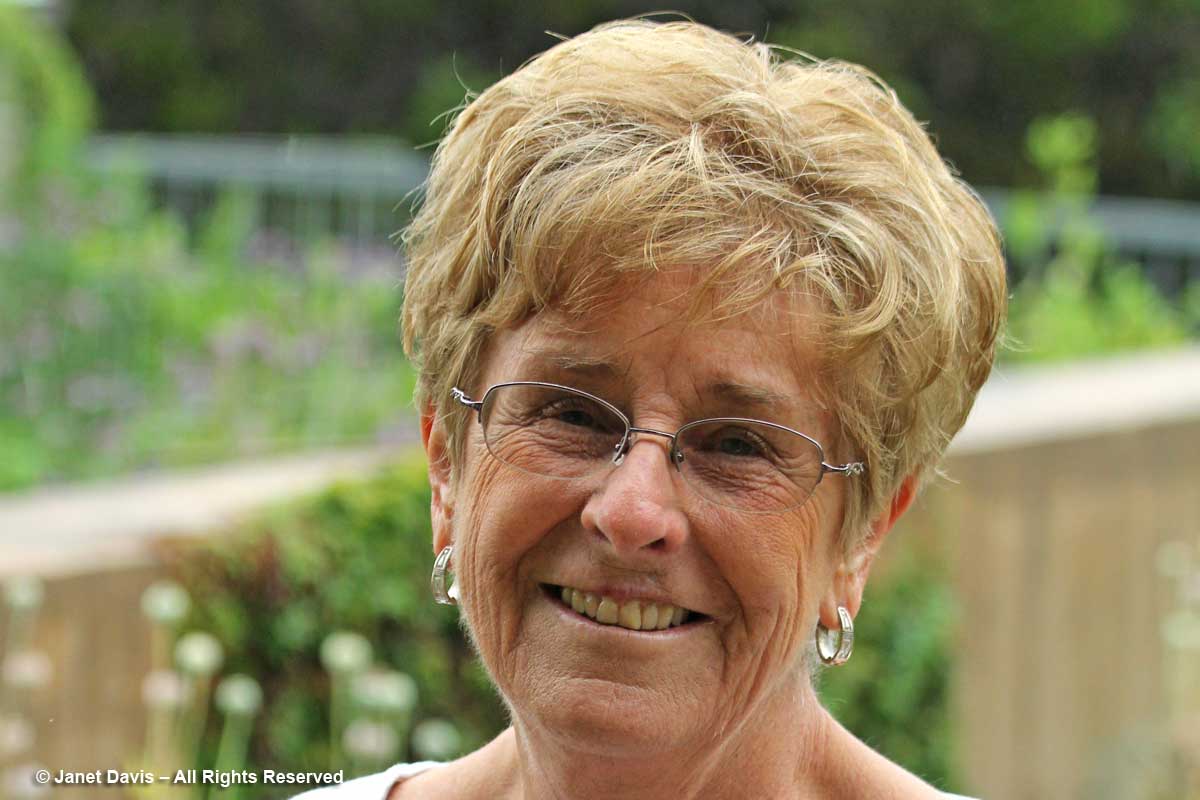
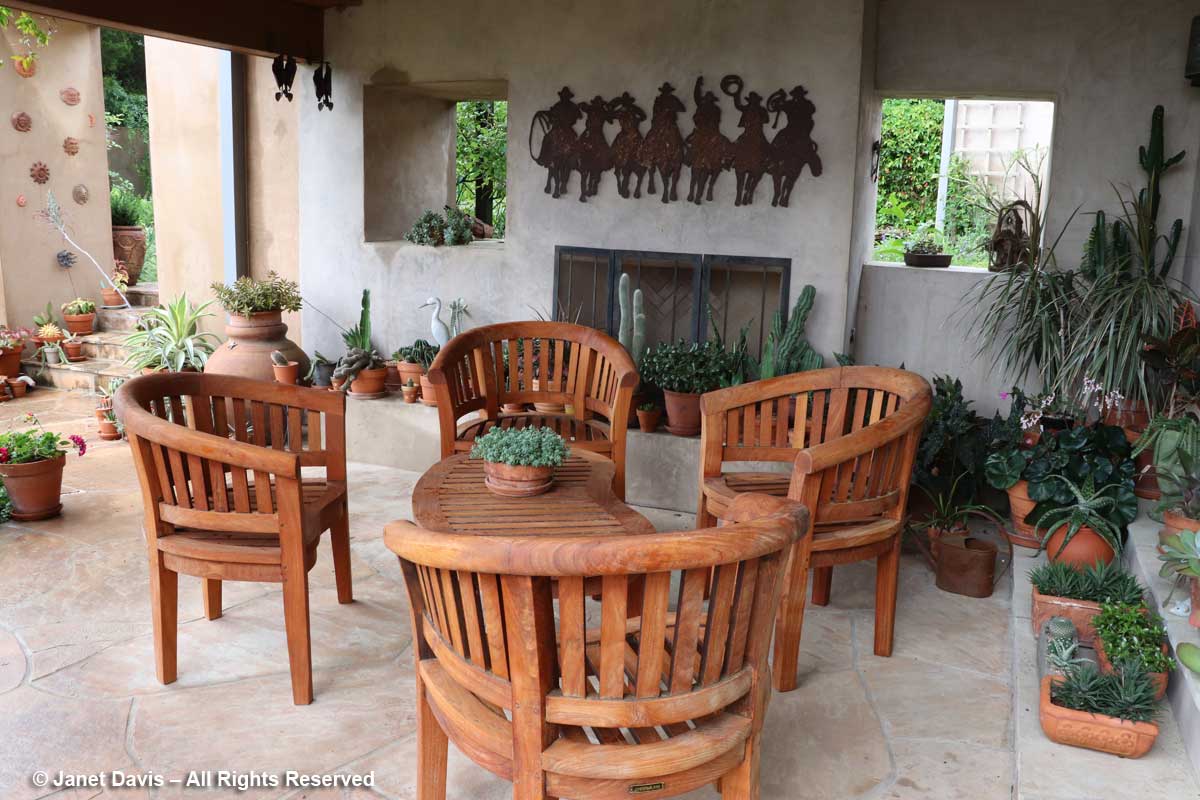
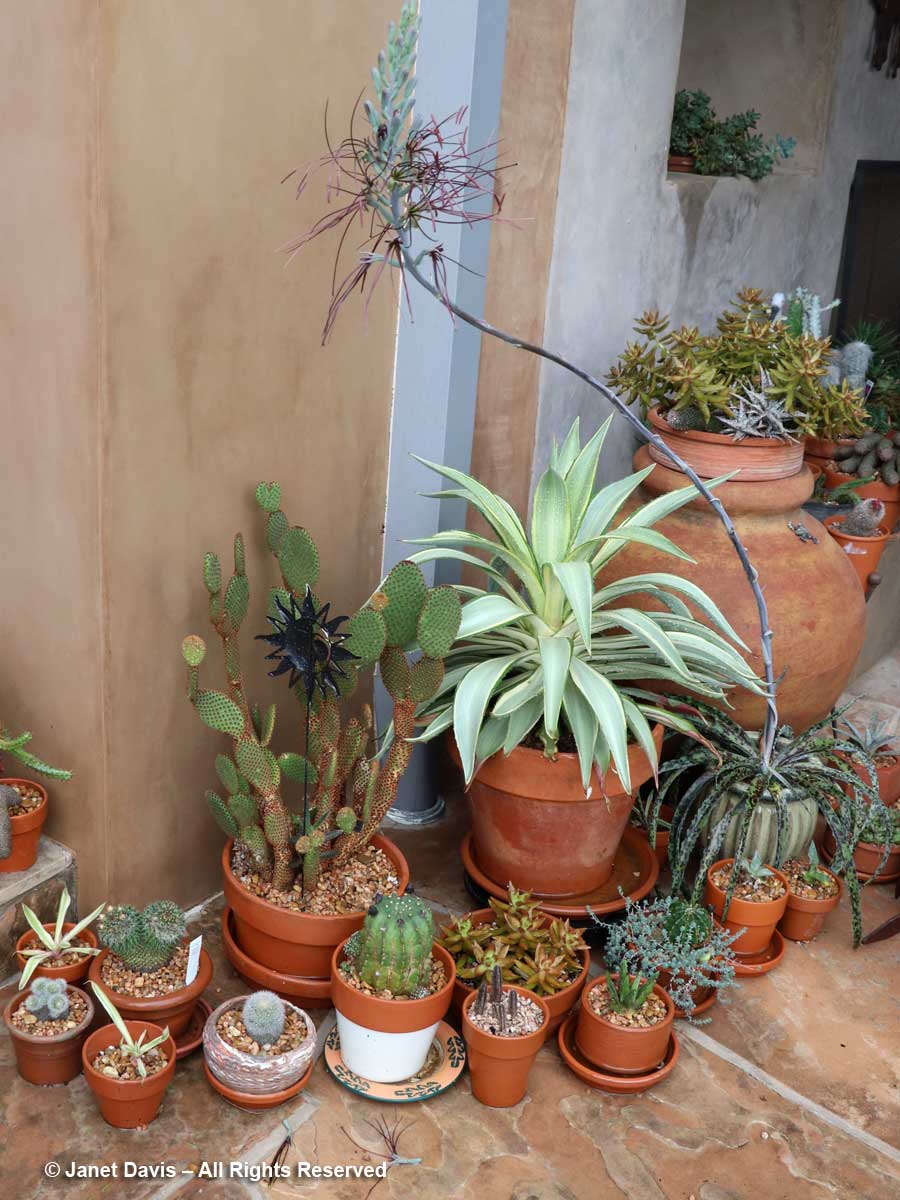
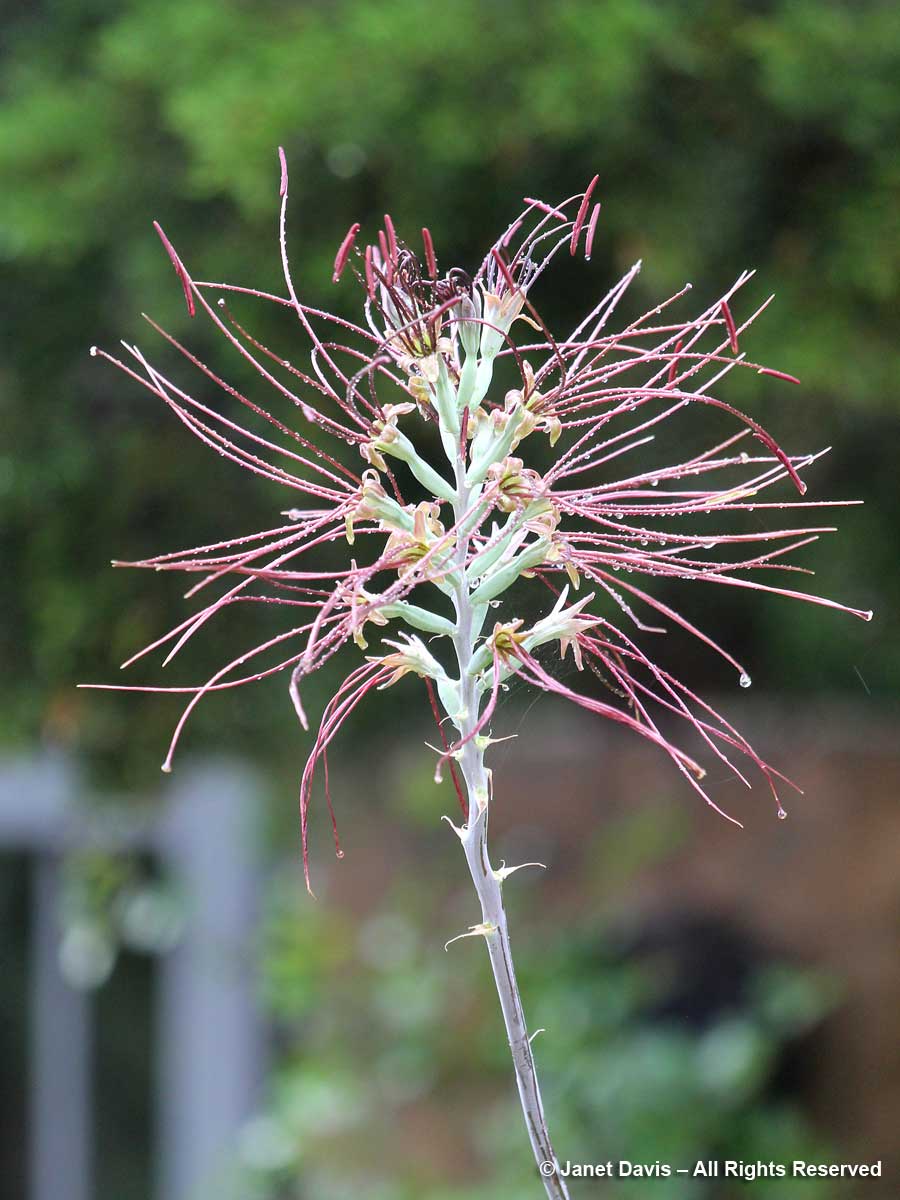
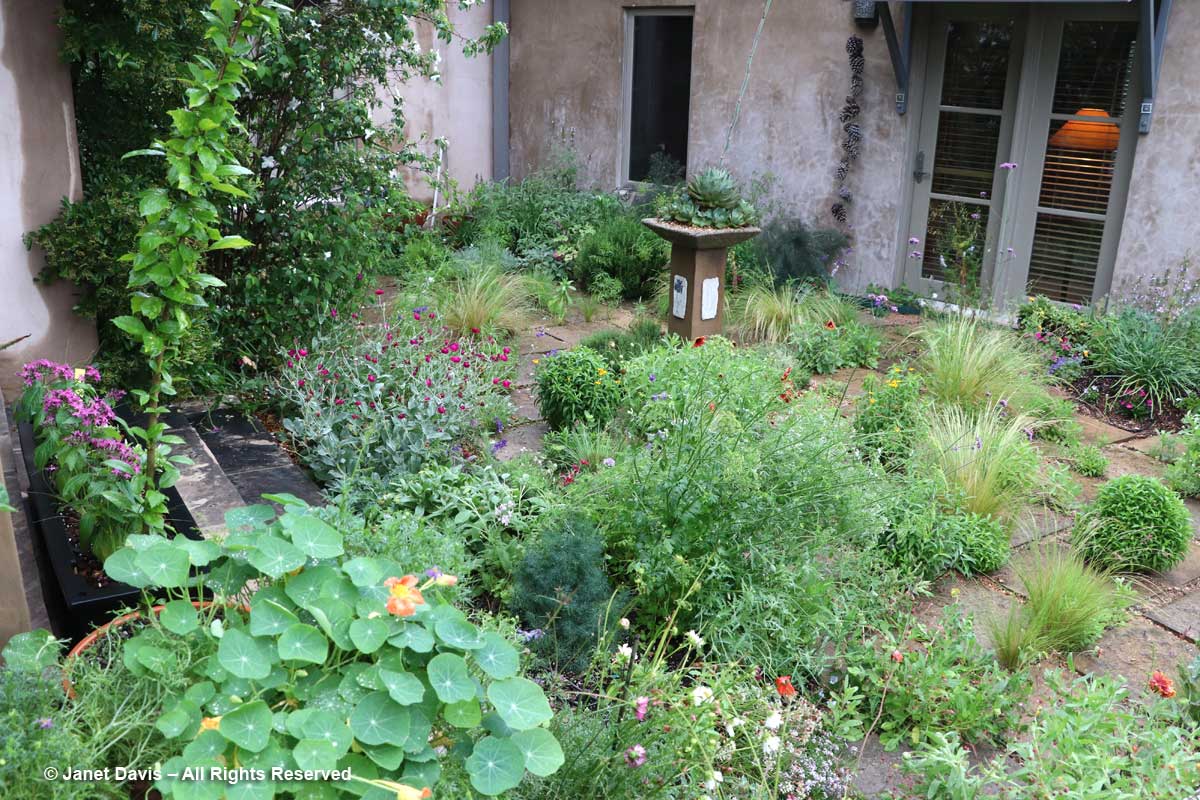
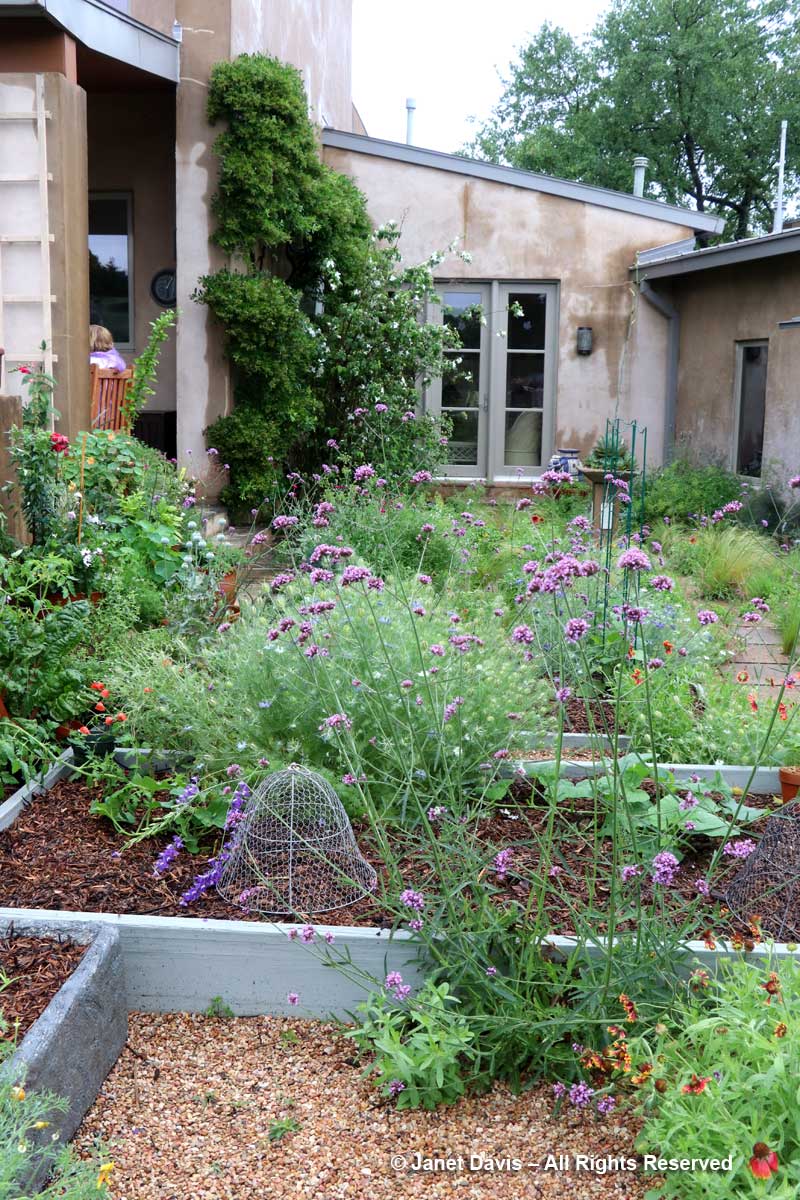
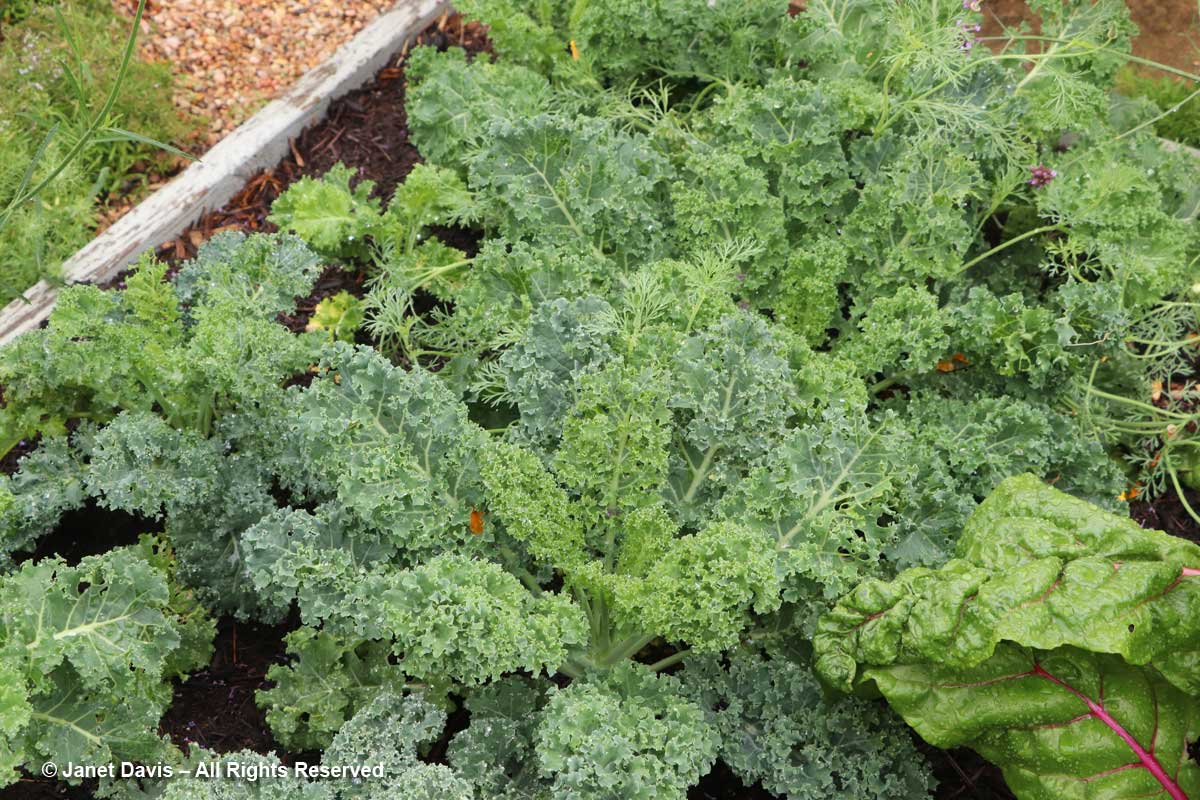
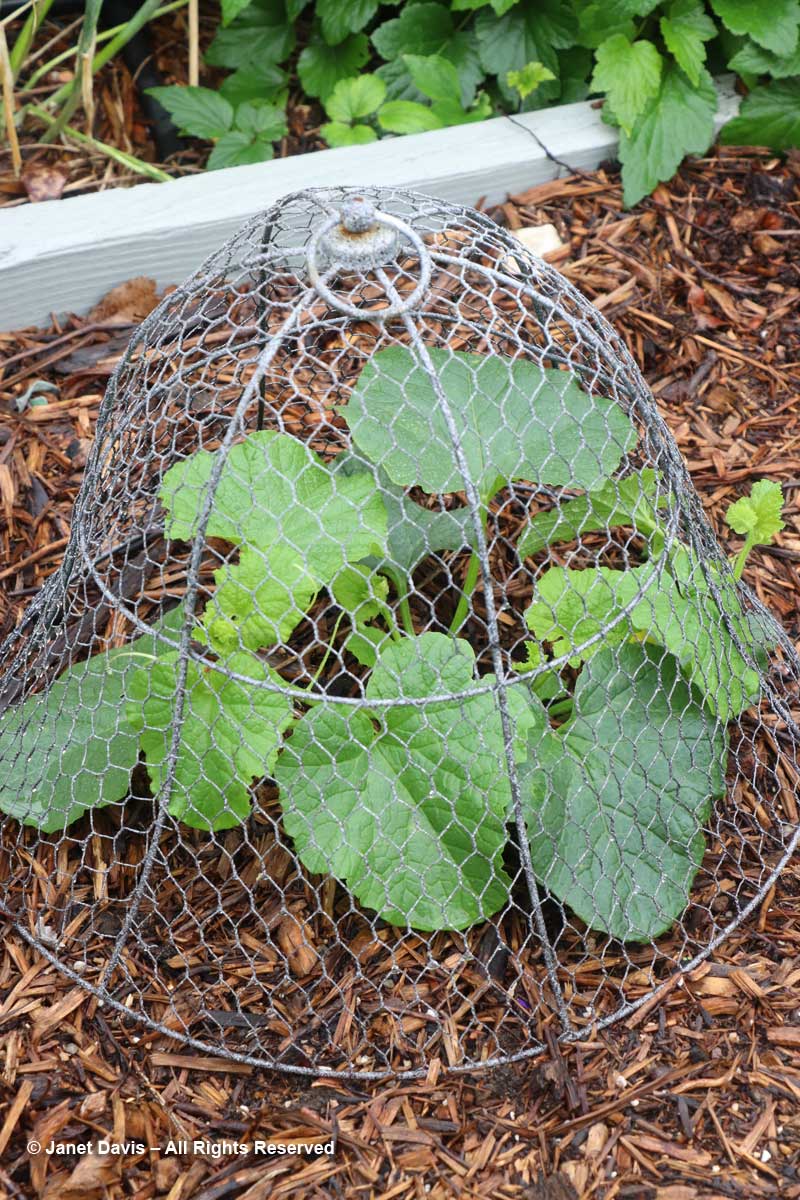
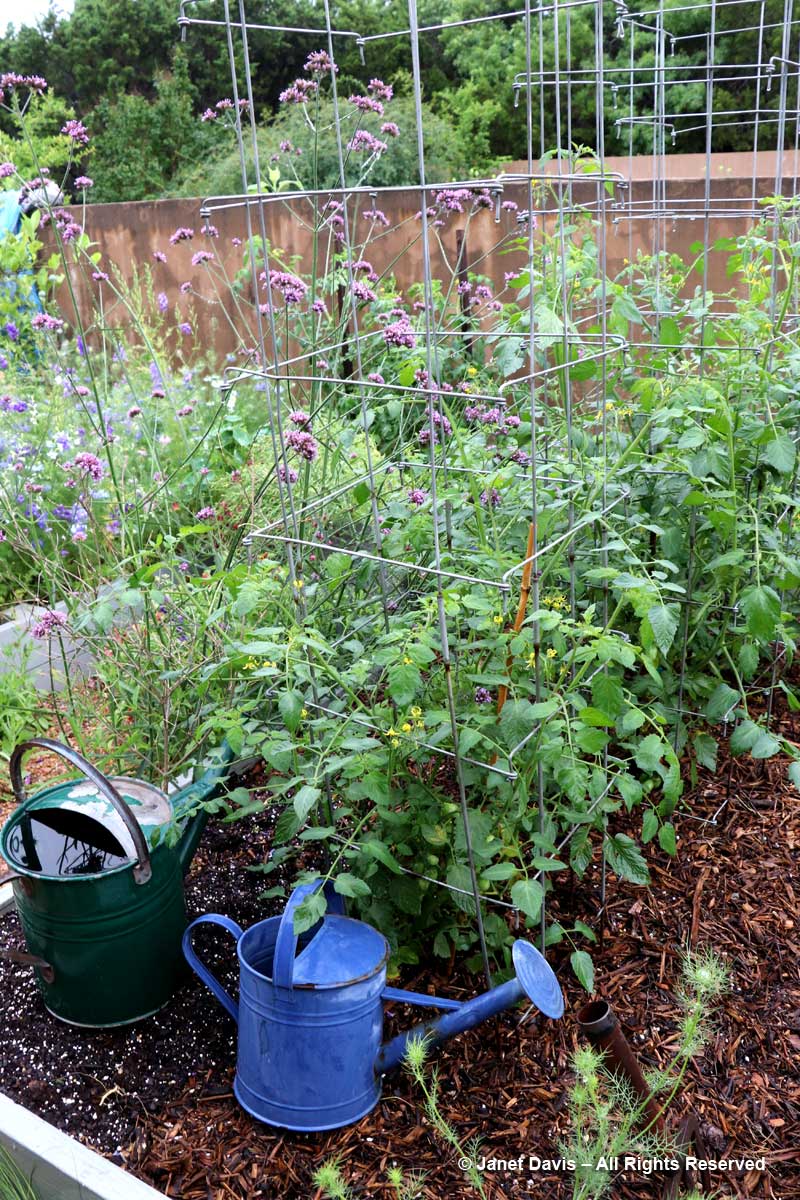
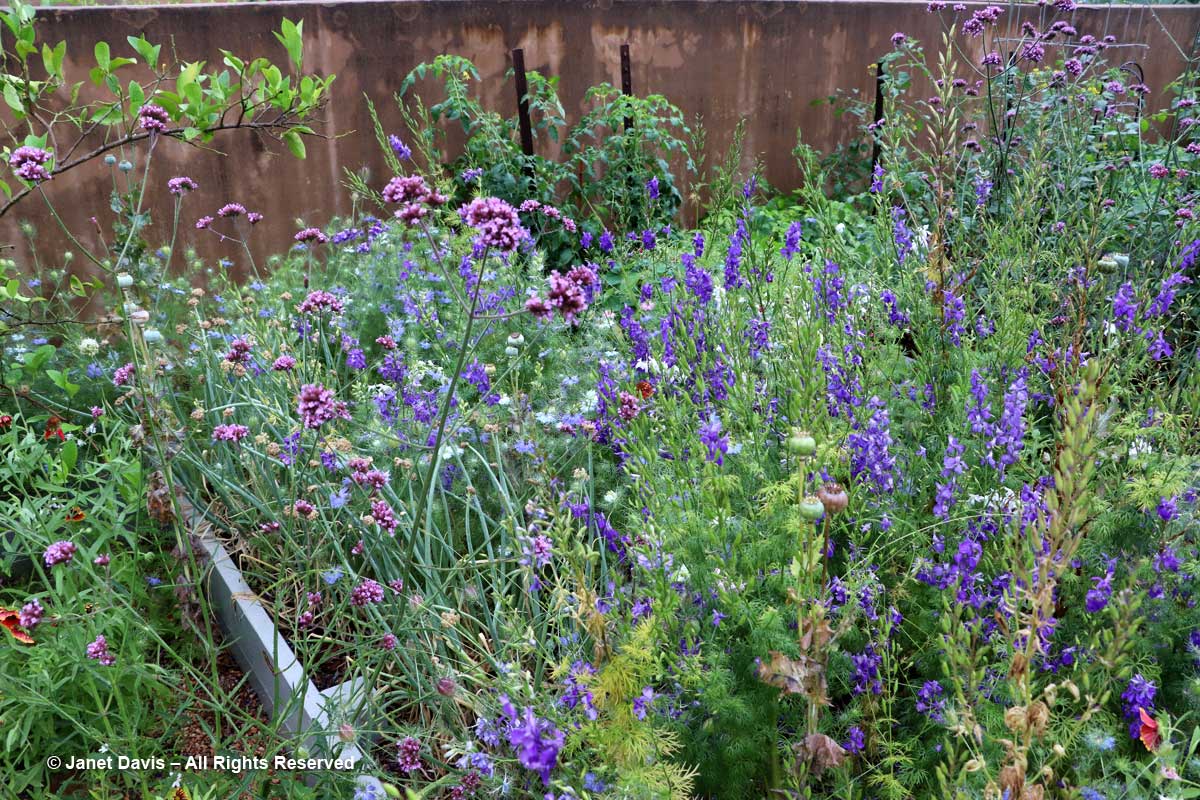
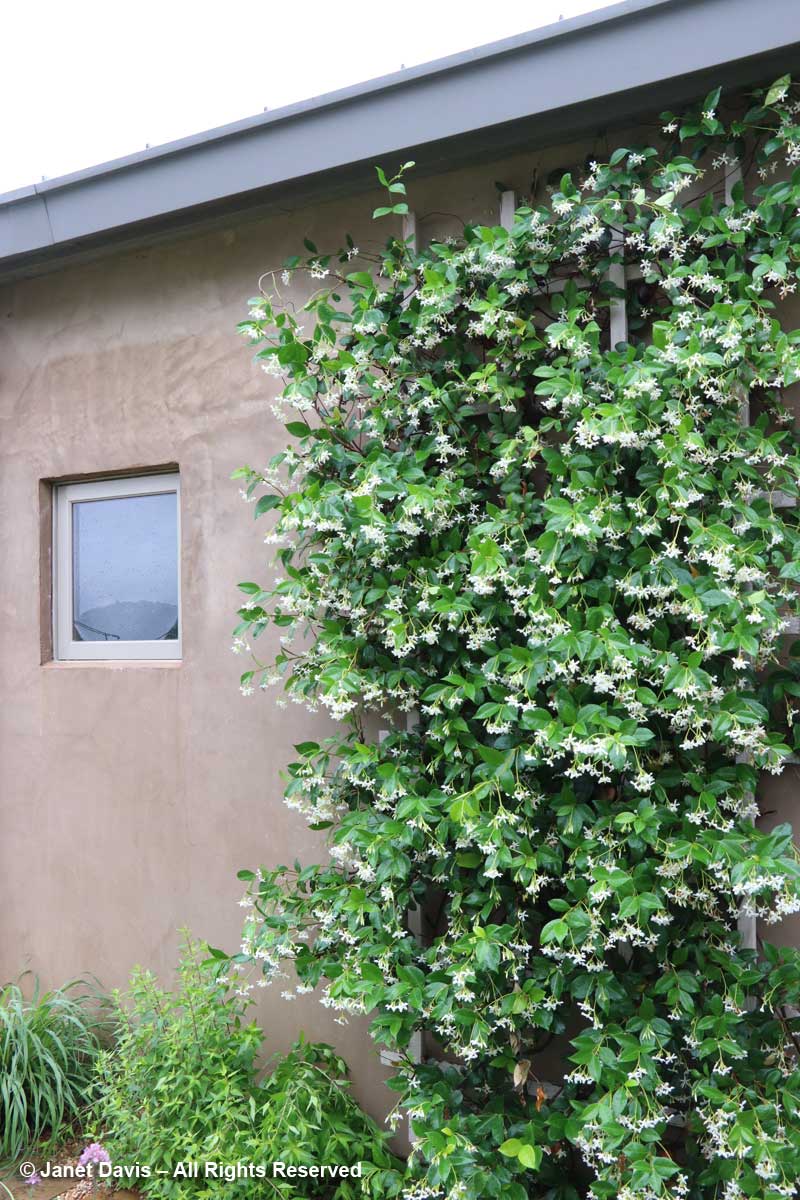
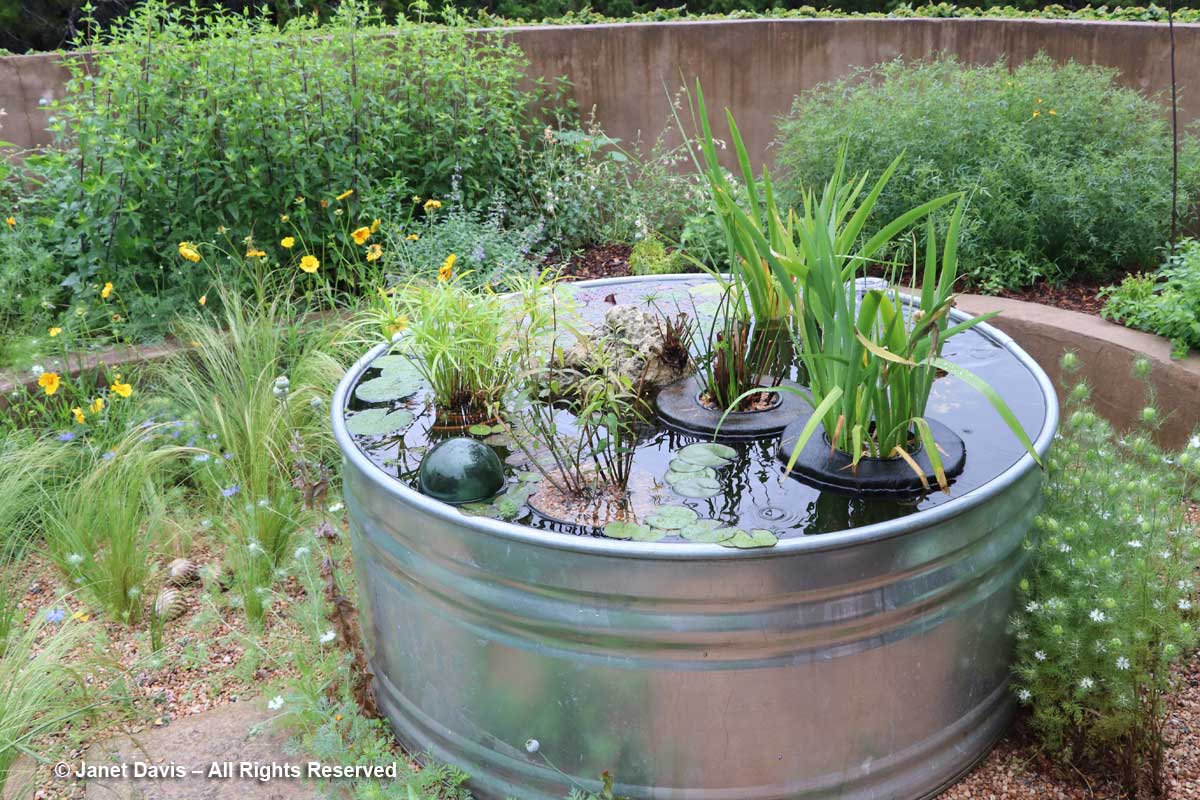
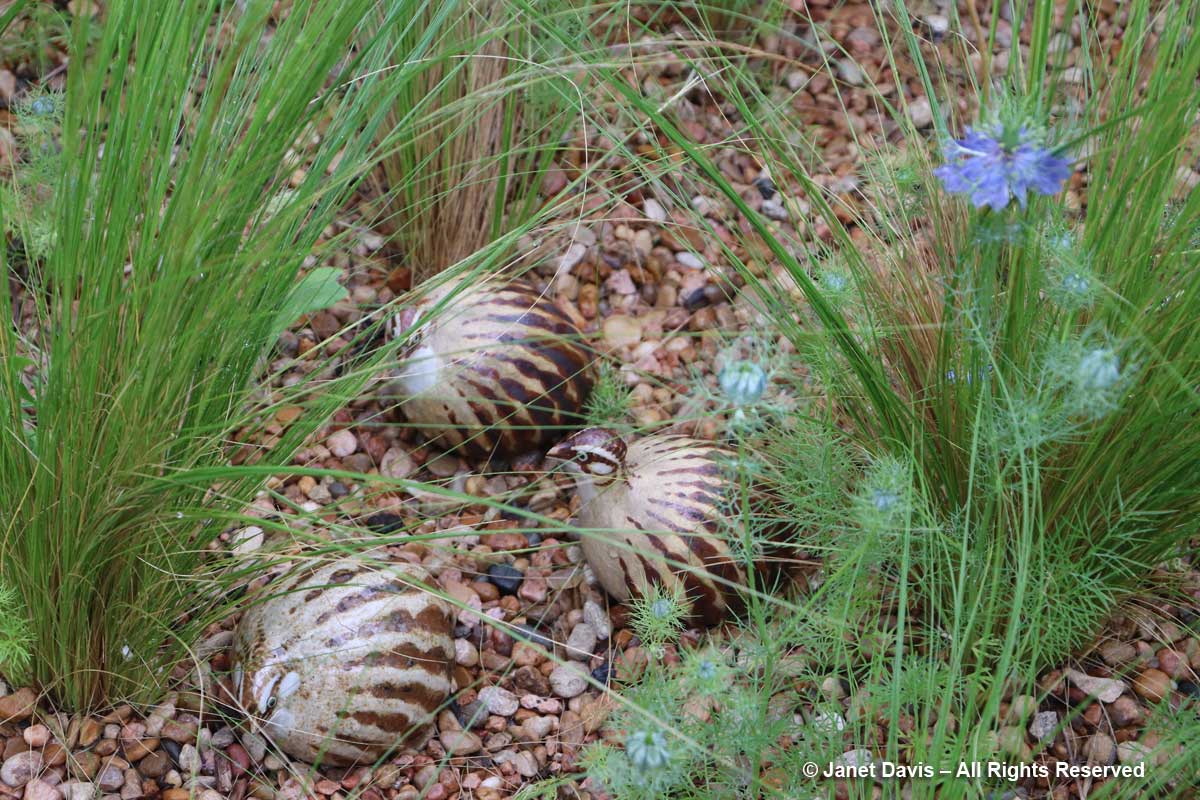
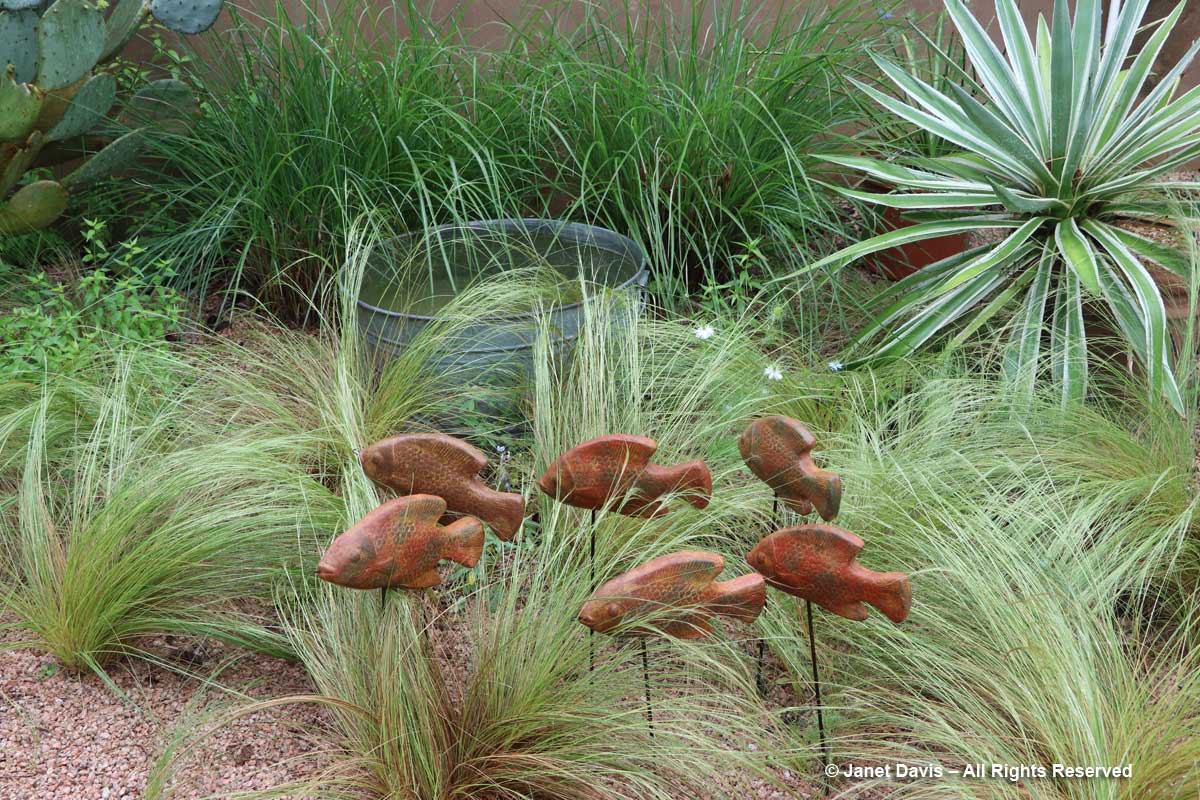
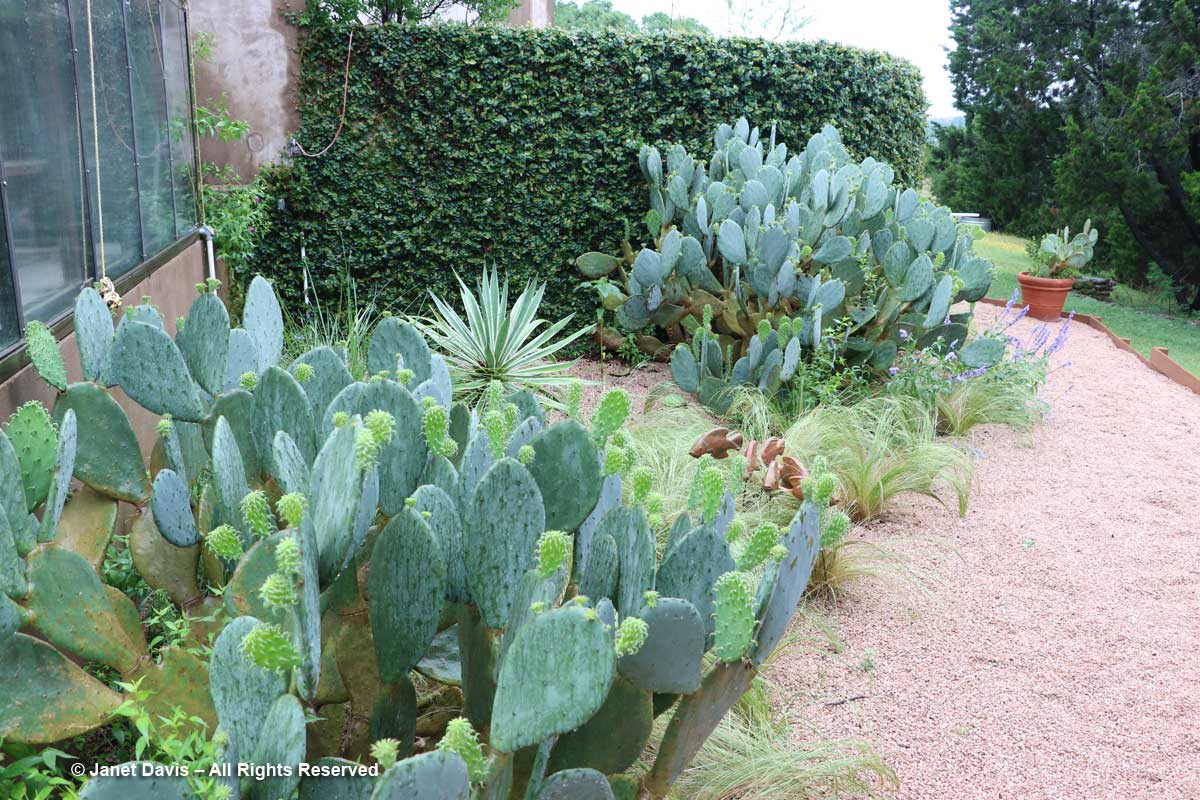
I’ve read many blog posts about Jenny Stocker’s garden, but however many I read, I see something new and interesting in each. It’s fascinating to note how different people see and take notice of different things, The photo of the acquilegia is very special.
Thank you, Pat. You would have loved all the gardens, but Jenny’s was very special.
Thank you so much for this lovely post of my garden. The conditions were not really favorable for photography with all those soggy plants and sodden walls but you managed to capture much and well. It is always fun to read what others think of your efforts in the garden. Something I need to work on is to get my garden looking good in all weathers. But rain is such a rare event here. We have so many sunny days. I never got the chance to chat with you. Many years ago I gardened in Canada in Brockville, Beaconsfield and Oakville and I remember how well things grew there in that much shorter season. Oakville was one of my favorite gardens. I plan to take some time and read about the house and garden you built in Ontario.
Jenny, I also used to garden in Oakville — from the late 1960s to the late 1980s. I wonder if we were there at the same time???
We were. We left Beaconsfield in 1977 and left Oakville in 1981.
Jenny, thank you. And I’m sorry we didn’t get to meet, but it was a confusing morning with the rain and all. And I always focus on trying to see as much as I can in a garden, so I likely just ignored you and concentrated on your flowers! Re the rain, there’s a saying in photography: Sun is your enemy! Therefore I was happier with my images from your garden than I was from all the sunshiny gardens. 🙂
Great post, Janet! I was also happier with my rainy-day Austin shots, especially of Jenny’s garden. It was a favourite for me, too.
Thank you, Helen! We’ve had no share of ‘overcast’ light here lately. Kind of makes me miss that pre-summer summer we had in May….